♖ Naval Fortifications – The art of coastal defence
Harbour defences, sea forts and fortresses, naval batteries and naval sieges in history.
Introduction:
Naval Fortifications is quite a wide topic, spanning centuries and even millenia. When defenders saw a strongpoint on the coast to defend the entrance of a bay or harbor, the reflex was often to create a fort. The sea is the best moat available, perfect in combination with cliffs and solid walls on top.
The first naval forts went back to the antiquity and even the bronze age. The ancient Mycenanean dotted the coast with forts. The Greeks and later Romans built castra (forts) to deal with piracy for example after General Pompeio Magno (Pompey the Great) “cleaned up” the Mediterranean in 60 BC; notably the Adriatic, Aegean sea, and Asia minor, down to the Syrian coast. Many of these strongholds were later converted into medieval forts.
The medieval era is well known for its castles, like those William I of England built to rule his newly conquered island after 1066, but it’s really when the age of gunpowder commenced before the Renaissance, that gunnery started to appear on coastal forts, seen as a way to sink or repel ships better than past catapults, ballistae, mangonels or trebuchets.
The idea was to use these “unsinkable man-o-war” to defend restricted access to harbours and coastal cities, often created in naturally protected bays. A couple of well-placed naval fortifications indeed could interdict an entire area to whole fleets, the gateway to a country, or its trade.
In the XVIIth Century when fortifications became a science (and the art of building them and taking them), naval fortifications multiplied as well, at an age of global empires and fleets in being. When better guns in the XIXth Century (Industrial era) outmatched fortifications, naval forts were refined and never completely lost their potential.
The American Secession war in 1860 started by the assault of Fort Sumter, and the Crimean war was mostly a naval assault on fortifications (Russians), as well as in WWI, the same allies assaulted Turkish Ottoman forts… to be defeated by mines.
In the interwar, fortifications were still relevant and still built or modernized, just as the Maginot line or Eben Emael and many other modern forts were constructed at great cost and ingenuity. At sea, the USN invested much in naval fortifications and perhaps reached the pinnacle of the genre with its “concrete battleships” of the Philippines. Fortifications stayed active even in the age of the atom, during the cold war, but today, they are definitely seen as a relic of a bygone era, after being in service for a thousand years in some places.
Antique fortifications:
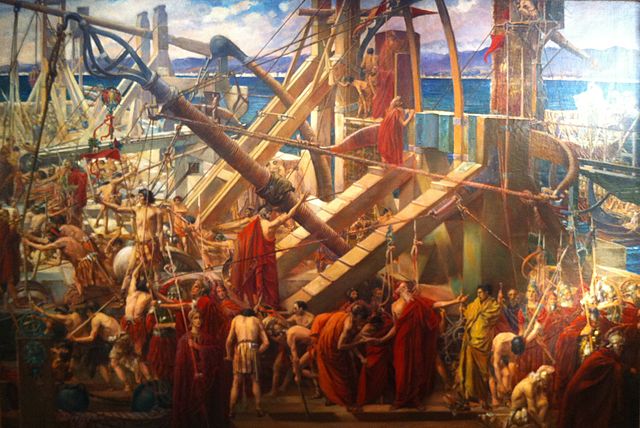
Archimedes directing the siege of Syracuse
Before the age of gunpowder, forts were just coastal garrison cities, but could offer some protection against an aggressors with their slings, bow and arrow, and later and ballistae and catapults when they appeared in the Vth Century BC. The Greek and Phoenicians built commercial empires and harbors all around the Mediterranean, placed on the best covered bays, often using narrow entrances. The latter were the best places to built at least an observation tower, to warn the defenders of the city state of an approaching fleet, such as Troy when the unified Greeks arrived on their shores. Famous city-states of the classical era drove their wealth and power from trade, and affirmed their mastery not only by their fleets, but their high walls. Like Athens which created a whole “fortified corridor” between the city and the Piraeus harbor also fortified. It was so feared by the Lacedemonians that peace conditions at the issue of the Pelopponesian wars included their dismantling.
When Alexander the Great tried to conquer the Persians, he tried to eliminate the all-powerful Persian fleet by taking coastal cities by land, one by one. The siege of Tyre (332 BC) showed how far a coastal fortified city of that era could withstand and assault. Later, Rhodes was also besieged and held off all attackers. The diadochi era saw a flurry of siege and fortifications building, with sometimes continuity between a coastal city and harbour, like the long walls running from ancient Athens and the Piraeus, destroyed by treaty at the end of the Peloponnesian wars, won by Sparta backed by Persia. One of these prominent warlord was even called Demetrios “poliorcete”, the “city taker”, and the size and capabilities of siege engineering reached an all-out summit. The Romans would later leanr a great deal about these technologies and improve them.
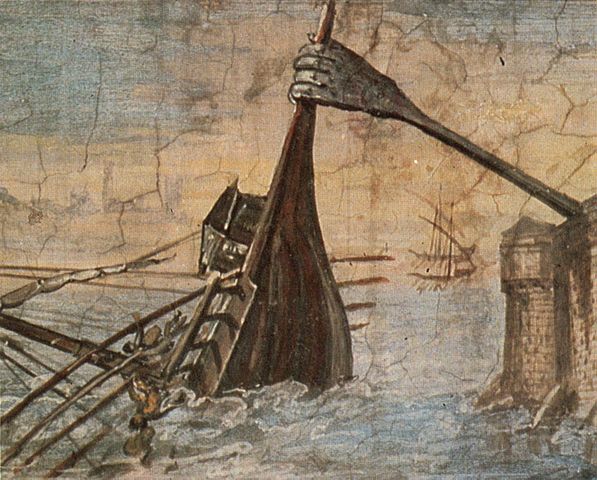
The “hand-claw” allegedly designed by Syracuse to defeat Roman ships
In between the second and third Punic war, naval fortifications reached perhaps an all-out peak with the fortified harbour of Carthage: The famous round harbour which protected the fleet, virtually impossible to take for any assaulting force. A wonder of construction of the antiquity, it was completely embedded on the city walls itself, the only access by sea was through a narrow passage that could be blocked by a chain, fortifications with archers and ballistae on both sides, and then the civilian port, and the military port inside a circular precinct. During the same era, the siege of Syracuse (214–212 bce) showed how far could be pushed the defense of a besieged coastal city, led by Archimedes himself. Although a part of the Roman tale is dubious at best, we can wonder how Archimedes contraptions were effective. Fact is, they were never repeated anywhere else.
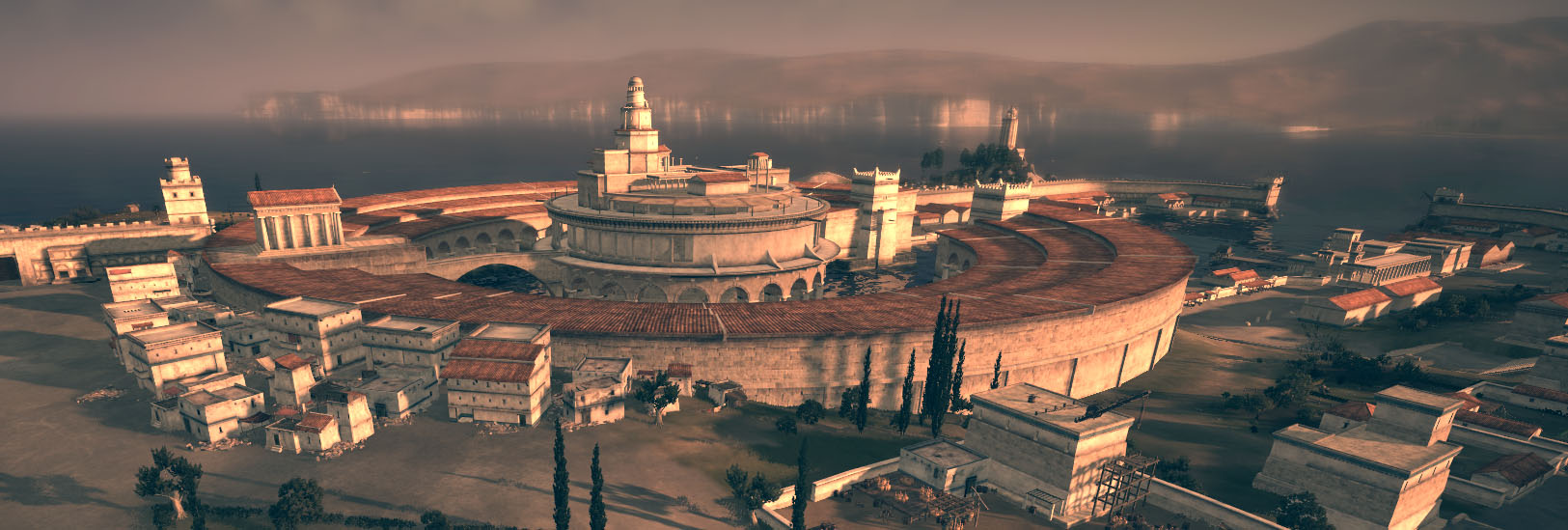
The military port of Carthage in 147 BC.
Medieval Sea fort:
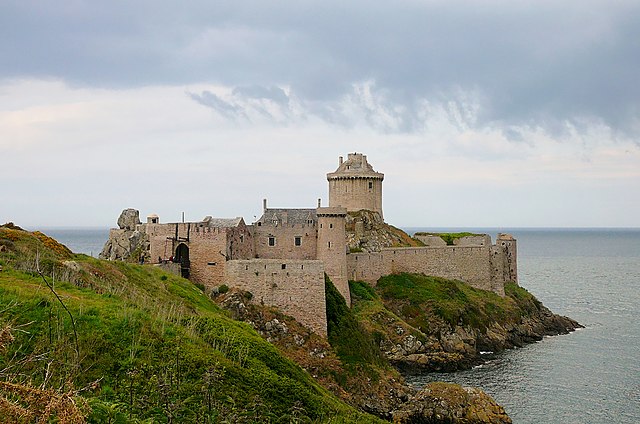
The Roche Goyon Fort in Britanny (1340). Its location made it impregnable and it played an important role during the hundred years war.
Preventing sea invasions involved two types of forts: Primitive “castra” partly in wood close to the coast or back to a cliff corner, in order to reduce the land surface to defend, and river forts, that can defend an inland city. Such forts were built upstream near Paris during the Viking invasions and contributed to repelling these. But another way to defend the land was to have a major fort deep inland and coastal outposts with a string of alarm fires along the way. Once an invasion was detected, the alarm fire was the quickest way to mobilize the army. Well before the Vikings, the Aegean sea “sea peoples” became a nuisance and coastal defences probably erected by civilizations neighbouring the Mediterranean.
The main problem of riverine or coastal forts was with bow and arrows only, it was difficult to interdict a sea invasion of any sort. Ballistae and Catapults were probably required to get the extra reach to do some harm to the approaching ships. The idea of using a chain to block access in a natural bottleneck is another fairly old idea, as well as using a boat barrage across the river. At sea however, there was little ways to block the access of a fleet. The Fort La Latte (1340) was an interesting fort of the late medieval period, in stone and built over granite in a spectacular location, more usable to see the surroundings and defend itself than to prevent a fleet to pass by. Other examples includes the Crusaders’s 1228 Sidon Sea Castle in Lebanon, Mt St. Michel in Normandy, Bodrum castle in Turkey, Mackenzie castle in Scotland and others.
XVII-XIXth Cent. Naval Fortifications:
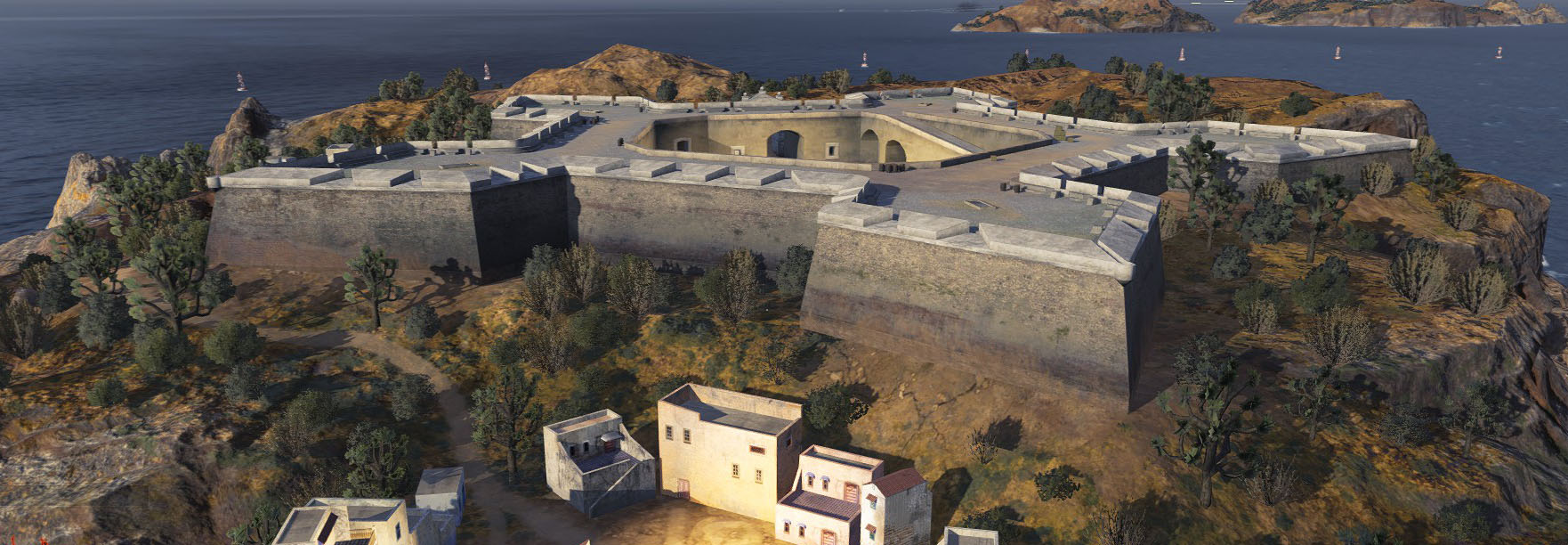
A Vauban fort: The typical close quarter fortification built from the XVII to the early XIXth centuries.
Around 1327 the first cannons appeared in Western Europe, and in time, they not only revolutionized naval warfare, but also land warfare, and naturally they became the main reason why naval fortification mattered again, and this until WW2. For once, cannons could reach ships at a distance no other medieval weapon was capable of, including a trebuchet. There was a newly-found interest to fortify specific points protecting a bay, an island, a natural passage towards a port or cove. This came in addition to another benefit: Contrary to a ship, a castle cannot sink. Al long as technology allowed forts artillery to stay relevant against ship-borne artillery, this was an even match.
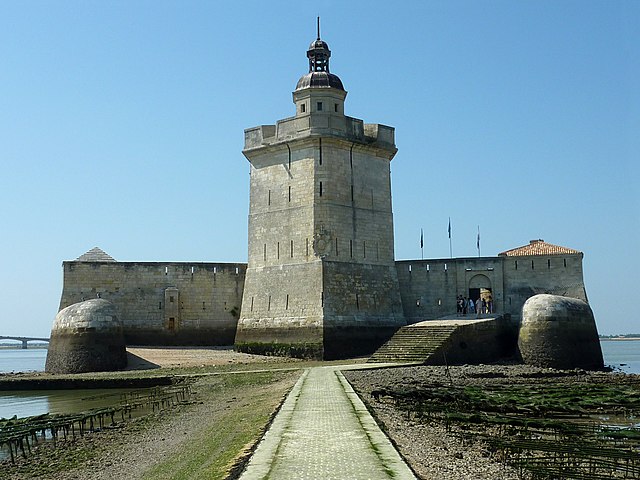
The spectacular Fort Louvois (1690), protecting the Charentes inlet, main way to Bordeaux. It was opposite to the Oleron island citadel for a crossfire, and one of the many first build under Louis XIV. Louvois was replaced by Vauban which dotted the coast with more citadels and sea forts, protecting the entrance to the seine river.
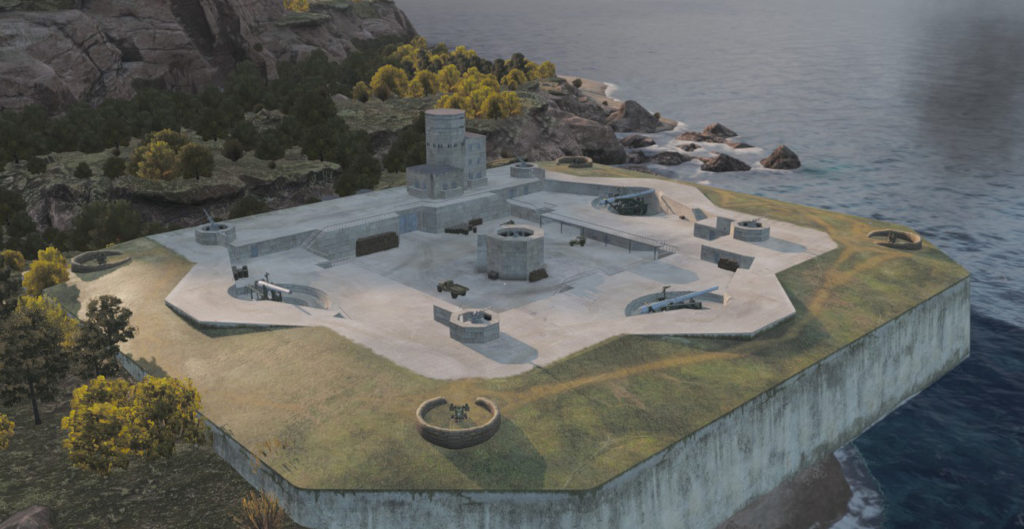
A late 1880s naval fortification: Heavy guns are using an hydraulic recoil system allowing them to be quickly back in position after loading, the latter made just as the barrel ended its recoil course. It allowed to quick fire heavy guns, but the installation was too extensive to be installed in a cramped turret or even barbette, so better suited for naval fortifications. The British had two such guns defending Gibraltar in case of an attack by the Italians, which in 1882 had the largest naval guns ever on a ship, the barbette ironclads Italia and Lepanto.
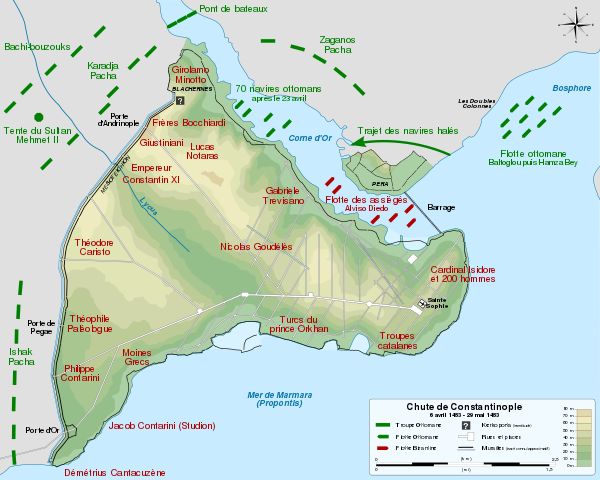
Naval fortifications played their role at multiple occasions, especially when the Ottoman Navy was head and shoulders in one of the most fantastic and decisive sieges in history: The Fall of Constantinople. Naval fortifications played a huge part in this, especially as the city was basically split in two, controlling access to the black sea. For once, the walls were nearly impregnable, and the Byzantine created a chain barrage at the entry of the golden horn. Further below, on reclaimed Turkish-held shores, the Ottomans built two forts, one on either side, with powerful artillery to impose a blockade. To circumvent the problem of the barrage, ships were hailed outside the walls of Pera, on the Asiatic side, across wooden ways, and to the gold horn, and a boat bridge was bridge further north. After the fall of the city, largely due to the land siege, the Ottomans learned their lessons and fortified not only the golden horn but also the Gelibolu (Gallipoli) peninsula. Old forts were rebuilt and modernized with German Krupp guns before 1914 (see later).
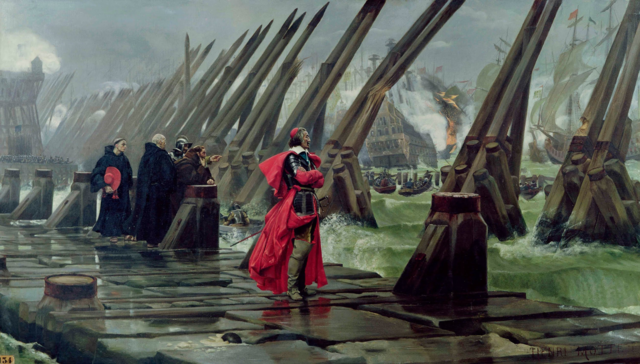
The siege of La Rochelle, in 1627. Painting by Henri Motte in 1881. The protestant stronghold, bolstered by British forces, held the French Catholics led by Cardinal Richelieu (which plays a large part in the funding and organization of the French Navy), lasted for about a year, from 10 september 1627 to 28 october 1628. To prevent supplies by sea, Richelieu started on November, 30 the construction by 4,000 workers of a dike 1,500 meters long and 20 meters high with foundations on sunken, backfilled ships and guns positons pointed towards the sea were to counter any reinforcements. Meanwhile a French fleet led by admiral Marino Torre blocked the harbour entrance. That was basically a repeat of the siege of Alesia by Caesar, but at sea. Indeed, the british soon sent reinforcements, 80 ships under command of George Villiers, 1st Lord of Buckingham, which took the nearby Island of Re, and later a second force by William Feilding, 1st Earl of Denbigh, in April 1628, arriving in May with 60 ships and 6 armored barges. Both failed and the last was sent in August by admiral Robert Bertie, 1st count of Lindsey with 29 warships and et 31 merchant vessels. He battled against the Dike and withdrawn in September. The city capitulated one month later. Richelieu showned a fortfied, gun-armed dike could hold its own against fleet assaults. The lessons were well laerned.
During the The Russo-Swedish War of 1741–1743, naval fortifications also played their part. Vyborg and St Petserburg were not only strategic harbors and arsenals, their approaches were also riddled with Vauban-style fortifications. For the Russians, the waterways in the Gulf of Finland became of strategic importance and small islands constituted unsinkable battleships, trigerring the construction of specialized artillery forts during the XIXth century (see later). The Fort Alexander I, defending the access to St Petersrburg was one of these Kronstadt string of fortifications, quite important at the time, built 1838-45. It was active during the Crimean war, which took place both in the baltic and black sea (sevastopol).
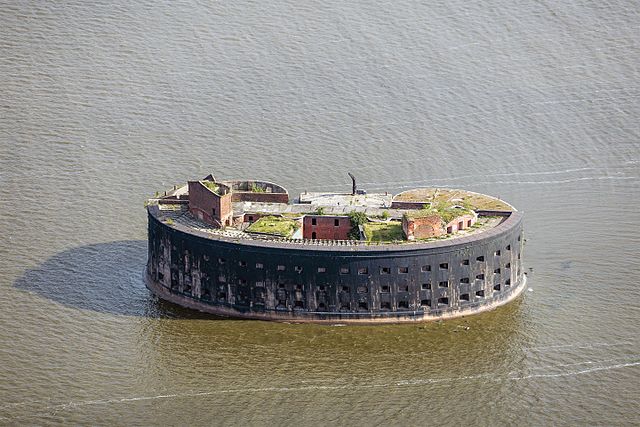
German Fortifications
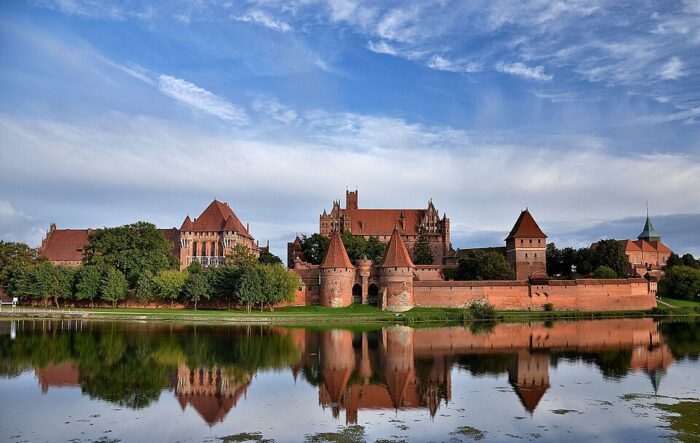
The venerable Teutonic Knight’s fortress, strategically placed on the Baltic at the entry of the Vistula, Malbork.
Fortifications before and after 1870
Prior to the war of 1870 that resulted in the German Empire, Prussia had a Baltic coastal worth defending and was indeed dotted with a number of forts, mostly to protect waterways and ports, but also on rivers. For example Prussian military engineer Moritz Karl Ernst von Prittwitz (1775–1885) designed the fortress of Ulm on the Danube, to protect the state of Württemberg in the early 1840s, after working on the fortress of Posen in 1828. He also worked at the Danube bridgehead at New Ulm in 1842. Von Prittwitz designed the large rectangular reduit of Wilhelmsburg on the north side of the enceinte built in 1844-1848, part of the larger Wilhelmsfeste (built 1842–1855). And this was Bavaria, from the Baltic. The other strongpoint defending waterways was at Ingolstadt, considered the second strongest in Europe after Verona. The Austrians also heavily defended the city of Linz.
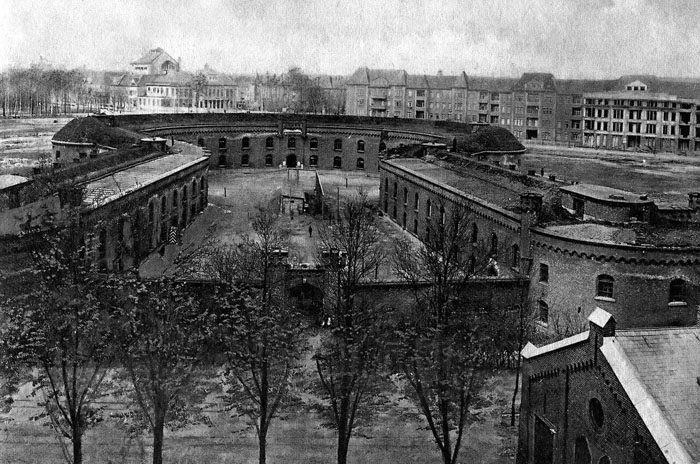
Eisenbahnfort at Königsberg
There were old fortresses on the Baltic made by the Teutonic Knights, and they had been more or less reinforced in Napoleonic times. The center of all these was Königsberg, which remained outside the new German Confederation. Königsberg received new defences based on General von Aster’s designs for the Prussian System, notably a new enceinte built 1843-1860. The Eisenbahnfort (railway fort built near the railroad station) was a bastion fort with a gorge reduit, two caponiers and a Carnot Wall. The existing bridgehead to Marienburg was also reinforced between 1846 and 1863. Along the coast after 1815, the old Swedish fortress of Straslsund (SW of Rügen) was also reinforced, with Prussian engineers building fortifications across from Straslsund in 1849 and 1850. They also enlarged the old fortress at the Oder at Stettin in 1846-1856 to accommodate a railway.
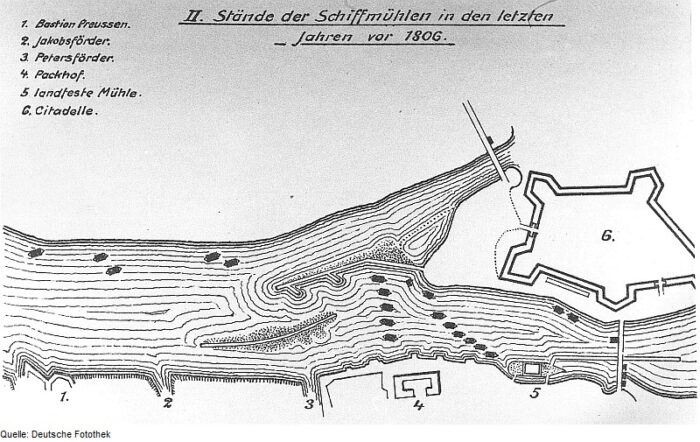
The Prussians major new fortifications were established in later Polish territory in East Prussia at Thorn (Torun) on the Vistula, from 1822 and in 1824-1832, a bridgehead on the left bank of the Vistula. From 1828 new fortifications in the Prussian System style were established close to the enceinte but instead an hexagonal Eisenbahnfort near the railroad was used a revetted counterscarp with Carnot Wall, three caponiers and features of the Polygonal System. It was Thorn which was supposed to block a possible Russian advance down the Vistula towards East Prussia. At Graudenz plateau on the Vistula’s right bank, a fortress was already built from the late 1770s and completed by tearing down the walls of the castle of Rogoźno northeast, but this stopped with the Napoleonic era and it took until 1848 to complete this new fortress.

In 1848, the March revolutions brought the first German parliament; in Frankfurt am Main and the first war with Denmark over Schleswig-Holstein. The Navy back then only had a few frigates and corvettes, way below the level of the Danish navy. But Prussia used well its artillery, and at the battle of Eckernförde, German coastal artillery managed to sink the ship of the line Christian VIII and disable the frigate Gefion, captured, then integrated into the German navy as Eckernförde. After the status quo ante and end of the revolution and national assembly in the Paulskirche, the small German fleet was dissolved. A new defensive core was reconstituted around the frigate SMS Gefion and the fleet still struggled in the second war with Denmark in 1864, and needed the help of the Austrian navy, but even combined, they were still too small to beat the Danes albeit the latter had some successes by establishing a distant blockade, so out of range of the Prussian fortifications that defended important ports. Nevertheless, Prussian managed to beat the Danes on land, taking Alsen, and the Danes made peace.
Before 1870, Prussian fortifications, wether they were land-based or coastal, had the same typical Vauban style simplified star scheme, most of the time, they were hexagonal and arrow-shaped (seen from above) with rampart, scarp, counterscarp wall and carnot wall, open guns positions and the casemate below. Krupp already provided all the necessary smoothbore guns for these.
The coastal forts network (Bältische Festung) plays its part in 1866 as said, as the Danes did not dare venture close to ports, and never attempted a bombardment to reduce these fortifications as did the French and British over Russian forts in 1856. One ultimate weapon in this game was the ironclad, but they were few and far in between, the Danes only had some, notably Rolfe Krake, whihch played an important role in the last war, but missed opportunitoes due to the strenght sometimes of mobile Prussian field guns batteries, that acted as deterrence. The Germans had several concepts of fortifications and a later classifications like the Eisenbeton for those composed of concrete reinforced by iron and later steel. Construction was entrusted to specialized teams, the Festung Pioneer Stab or Fest.Pi.Stab. When a gun casemate was involved, it was called a Geshützschartenstände. Sometimes fort netwrks were commanded from a CP or Gefechtsstande.
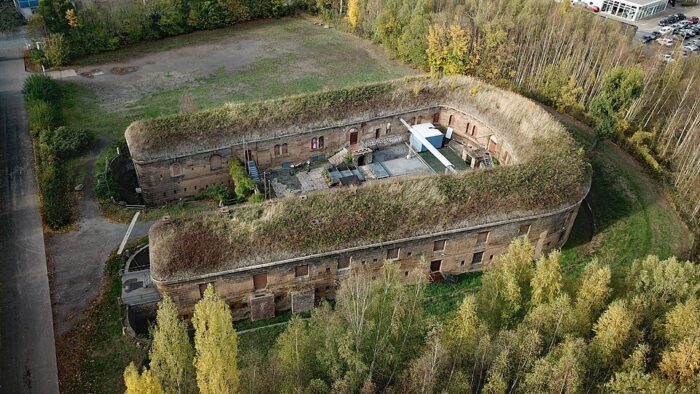
The Prussians also rebuilt the old fortress of Minden on the left bank of the Weser in 1815-1836 by expanding the defences to the right bank to cover the new railway station in 1845-1852 and included a fortified line with two horseshoe-shaped forts and a detached fort to the south of these positions. Increasing industrialization and advances in technology in the field of artillery made more important the adoption of girdle forts and in the 1870s, the military deactivated and even razed many fortresses like Minden. Erfurt on the Gera River had preparation made to receive girdle forts in the 1860s but it was deactivated also. Along the Elbe, Torgau was reinforced in 1815-1831 and again in the 1860s, notably the bridgehead on the left bank at Wittemburg. Magdeburg was reinforced in the late 1850s with twelve detached forts added and maintained its status until WWI.
Back to the Baltic, there was also the case of Posen (Poznań) on the Warthe River, a key position on the frontier between Prussia and Russia, located between Warsaw and Berlin and most advanced position in the defence of Brandenburg. General Karl Wilhelm Georg von Grolman (1777–1843) started work in 1815 and tried to turn Königsberg into a fortress, later creating a new fortress at Lötzen (Fortress Boyen). On Winiary Hill, north of Posen, was erected the citadel of Posen. General Johann von Brese (1787–1878) took up the project in 1828 and worked both on Fortress Königsberg and Fortress Boyen near Lötzen in 1844-1855. Feste Winiary was reinforced by Fort Hake. In 1864 the site was completed and upgraded to a 1st class fortress.
The Franco-Prussian War of 1870–1871 saw better equipped armies and if traditional invasion routes between France and the German states were used, armies now numbered well over a quarter of a million each, deployed along a front of over a hundred miles. The French Army of the Rhine was split by a faster concentration and instead of retreating and maintaining a continuous front, part of the army concentrated around the fortress of Metz while other withdrew to the west and formed the Army of Chalons, which later tried to relieve the force at Metz, for nothing. Both were surrounded and forced to surrender. This forced a drastic change in strategy postwar.
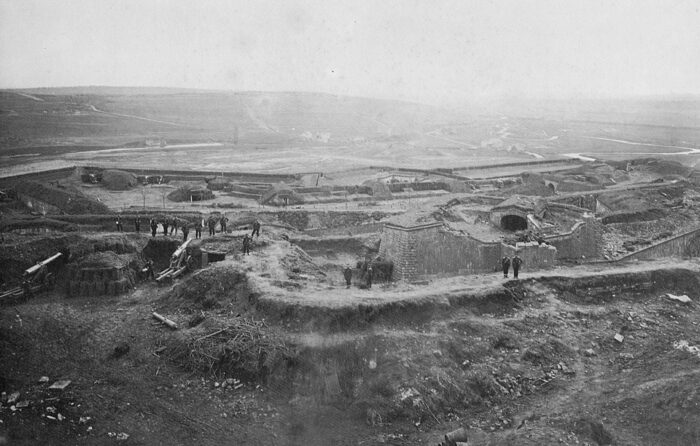
The naval side of the war saw the French, and the Marine Nationale absolutely dwarved the Prussian Navy at this point, despite it had been reinforced by a nuber or ironclad and made several sorties. The French attempted to blockade German ports in the Baltic like the Danes did. However this time, German port fotifications had been reinforced and were an integral part of the Prussian Naval strategy. They were strong enough to deter the French to approach, so they maintained a distant blockade. Each time a sortie was planned against the French, it was planned to draw them back towards field artillery or forts. But the French overall could not support their fleet in these waters, they simply lacked the ressources to recoal the fleet at sea far from bases, and neighbouring states refused to give support, notably Britain, allied to the Prussians. After the victory, the Prussians secured Alsace-Lorraine and started to further fortify the Rhine River on which several key fortresses served as bridgeheads. Strassburg and Bitche had older fortifications to which the French added six forts for a fortress ring at Metz in the 1860s and the Germans in turn improved on these.
German Naval/Riverine Fortifications of WWI
In 1886, the French conducted experiments against Fort Malmaison, a new fort completed in 1882 against new high-explosive shells, to devastating effect. It showed that much traditonal fortifications were doomed and needed a complete revision. Gunnery was to be interred, and the masonry covered with a layer of concrete and another of sand and/or earth. It was also tested a new extra protection, the ‘burster layer’ of concrete to detonate the explosive shell before it penetrated. This modernization went on in the 1890s and was completed or ongoing in many border forts by 1914. Naval solutions were integrated into the mix, such armoured casemate (with the same type of steel on iron armour used on battleships) to replace masonry casemates, albeit it was rare, as Germany already taxed its steel production wit Kaiser II’s massive Navy. It was thought that casemates presented a large target but had a limited field of fire and they were replaced when possible by a single rotating armoured cupola and later a disappearing turret. There were two namesin Germany associated with the type of fortifications that were developed before the war, Grüson and Schumann.
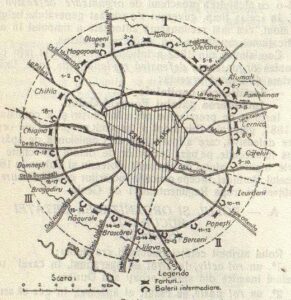 They notably took part in an interesting international competition (in which both the French and Germans took part) to provide Romania with a brand new defensive line, badly hit by the previous war of 1878 and gaining its independence. Under King Carol I from 1881 grand plans were made to defend the southern frontier against the Ottoman Empire and the coast, bu also the new capital, Bucarest, located on the Dâmbovița. General Henri Brialmont, a Dutch-born Belgian military engineer already known for his excellent work at Antwerp was selected, already advocating large turrets with 150mm guns to defend Bucarest. They were built in 1885-86. These fortifications included Grüson (Magdeburg) domes or mushroom-shaped turret designed by Schumann while St Chamond proposed cylindrical turrets from Henri Mougin that were rather “cheesebox like”.
They notably took part in an interesting international competition (in which both the French and Germans took part) to provide Romania with a brand new defensive line, badly hit by the previous war of 1878 and gaining its independence. Under King Carol I from 1881 grand plans were made to defend the southern frontier against the Ottoman Empire and the coast, bu also the new capital, Bucarest, located on the Dâmbovița. General Henri Brialmont, a Dutch-born Belgian military engineer already known for his excellent work at Antwerp was selected, already advocating large turrets with 150mm guns to defend Bucarest. They were built in 1885-86. These fortifications included Grüson (Magdeburg) domes or mushroom-shaped turret designed by Schumann while St Chamond proposed cylindrical turrets from Henri Mougin that were rather “cheesebox like”.
The Romanians opted for the Grüson turrets with twin Krupp 150mm (5.9in) guns, that were just 6.0m (19.7ft) wide internally and presented a very well sloped and redued target with less steel used thanks to the curves. It could resist a 270mm shell and made a full traverse in 30 seconds. Other fortifications included cast armour sections covered by cement with an additional layer of sand protection. Brialmont planned thirty-six armoured forts with artillery turrets around and six quite large. Apart 15cm Krupp guns, the French provided smaller Schneider and Hotchkiss guns. After this success, which influence later both French and German fortification work, Grüson chilled cast iron armour became the norm to modernize old fortresses. The defence of Romanian was completed in 1885 by Major Schumann which designed “Armoured Fronts” on the Sereth River with bridgeheads at Fokshani, Namalosa, and Galatz. Also in the 1890s with a well-developed railroad network in Germany, Grüson breveted portable turrets, the Mle 1892 panzerfahr, mounting a 5,7cm gun, brought on rails from a land carriage, wherever it was needed. This could be used on coastal defence as well, as railroads also criss-crossed the Baltic shore, in addition to main rivers.
German Fortifications 1890-1914
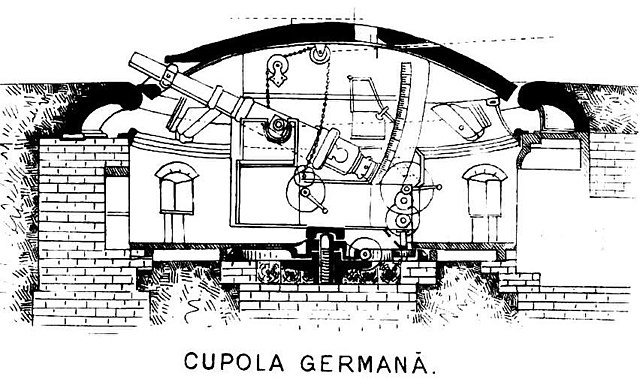
Work mostly focused on the land border with France and the Rhine. Indeed the coast was believed to be “safe” from a new French blockade given the geopolitical context did not changed much, unless the French obtained permission to use Russian ports (there was an alliance in place). But the scale of the German Navy and conversely, loss of power of the French Navy after 1870 now seemed lik a distant threat. More preocuppying was the strenght of the Royal Navy, which was closer.
Between the 1890s and 1914, the Germans committed still massive resources for new fortifications as well reinforcing old ones, just like the French albeit the latter were disheartened by their tests with high-explosive shells in 1886. Both sides were just content to add concrete and earth on old forts and the French better on the new iron turrets and armour and then steel, but the Germans were much farther ahead in the development of steel fortifications, notably after Krupp took over Grüson Werks in 1893. Grüson and Schumann previously defeated Alfred Krupp in all competitions. Grüson’s 1873 hydraulic system reducing recoil and cast-iron turret were kust superior to Krupp’s. Schumann also concluded a single gun turret was a better system because of its movement after it fired. Grüson and Schumann thus developed new a single-gun retracting turret, but it was rejected by the army as too complex and fragile. So for any new worked or modernization, 1890s Grüson turrets were always non-retracting. The French meanwhile privileged single 155mm gun and twin 75mm gun retracting turrets, even retracting machine-gun turrets. Grüson mobile turret also met export success with the Swiss and Romanians.
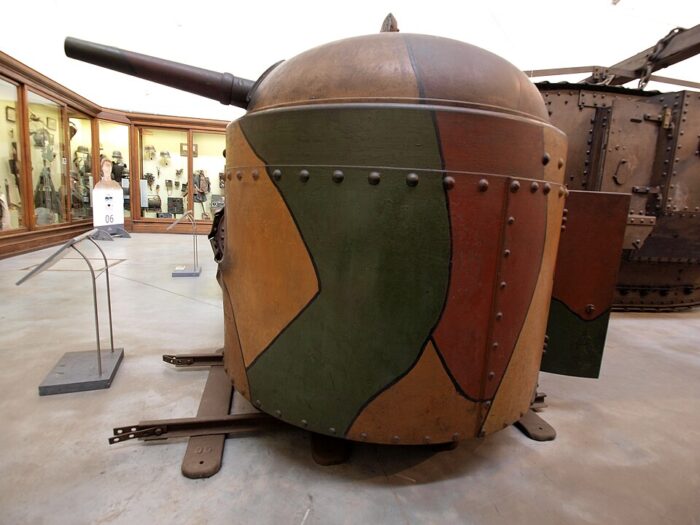
Grüson Fahrpanzer in WW1 with a 53 cm gun
General Alexis von Biehler became Inspector General of Fortifications between 1873 and 1884, and promototed his own design with a lunette-like outline, two projecting fronts, two parallel flanks like polygonal forts as well as caponiers reinforced with concrete and sand layers. Other forst received counterscarp casemates out of direct line of artillery fire instead of caponiers. Von Biehler modernized notably the fortress rings of Metz and Strassburg. Köln on the rhine was also reinforced by a dozen new forts creating a new, larger outer ring in addition to modernized older forts of the inner ring. Biehler was replaced by General Karl Bernhard Hermann von Brandenstein.
He soon proposed to fill interval positions to fill 2-4km gaps in the fortress girdles, ideas implemented after he died in 1886, when General F.W. Gustav von Stiehle took charge. Von Brandenstein reinforced the rings around Königsberg in 1887-1891 with concrete sandiwhched with sand to stop shell penetration as well as placing hermetically sealed armoured hatches and doors against gases. Nine of older forts at Posen were also modeernized, with zwischenwerke (interval works) and at Thorn, fourteen new forts were created between the 1880s and the late 1890s plus two armoured batteries with 150mm howitzers. In 1892, the Fort König Wilhelm I was completed, suing dispersed armoured batteries and turret artillery, with a trapezoidal fort and armoured battery of 210mm howitzers and four batteries of 150mm howitzers with infantry and munitions shelters added on the flanks in 1899.
Kaiser Wilhelm II became personally interested in planning a new system of forts, dissatisfied with Biehler, and notably championed the Einheitsfort or ‘unit fort’ in 1892-93. They were all standardized with 150mm howitzer turrets, 57mm eclipsing gun turrets and observation turrets, all made entirely by Krupp at this point. General Gustav von Golz (Inspector General of Fortifications between 1890 and 1893) also took part in the fortifications on the Rhine, at Mutzig. Metz, Graudenz, Thorn were reinforced in 1894-1899 as well at Thionville in 1899 and Istein while Fort ost was completed in 1897. Meanwhile thoeritcal works continued on these, from Colonel Herman Frobenius, Major Maximillian Schumann, K.J. Schott, and Bavarian General Karl Theodor von Sauer. On the other side General Henri Brialmont in Belgium and Commandant Henri Mougin in France were also well known. Brialmont in particular wrote entire strategies country-wide on how to position forts.
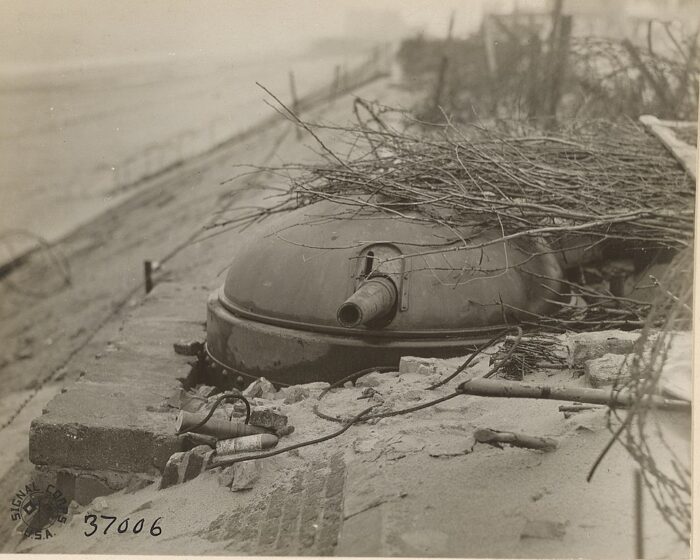
Farpanzer in Ostende
However there was also a powerful anti-fort faction at the German Parliament that advocated that high explosive shells made them obsolete no matter what and the army should focus instead on mobility, especially using the railroad network to use rail-mounted artillery instead. This was demonstrated superbly by the Russo-Japanese War and battle of Port Arthur in 1905, further reinforcing their point. Apart Metz, no major work was undertook in the following years albeit many modernizations were still ongoing until 1914. In the end, especially on the coast, there were little propositions but those of Von Sauer and his smaller and more dispersed positions or interval positions, as well as armored cupolas to replace ramparts.
Prior ot 1914 on their northern coasts, the Germans fortified their naval bases with batteries and forts armed with new Krupp artillery to protect their fleet. Despite the scale of the new Kaiserliches Marine it was thoerized that a small portion of the fleet could contest the RN, and draw elements of the latter towards naval fortifications if provided with heavy guns.
Wilhelmshaven, Geestemünde, and Cuxhaven on the North Sea, as well as the island fortress of Helgoland, Kiel, Swinemünde, Danzig, and Pillau on the Baltic were heavily defended.
Prior to the war, naval forts were the following:
Cuxhaven
: Three forts and six batteries. Fort Kubelback (1870s) had 10x 280mm guns. Fort Grimmerhörn (1870s) had batteries to which flak was added during the war.
Geestemünde
: (Weser River) had four forts, notably Fort Langlütjen I (9x 210mm guns in an armoured gallery), Langlütjen II and Brinkamahof II (Grüson turrets with 280mm and 150mm guns), Fort Brinkamahof I was the weakest with an open battery of 210mm guns. But more were added in 1915-18.
Wilhelmshaven
: Four forts (1870s), batteries of 280mm, 240mm, and 105mm guns. Outer ring with twenty Infantriewerke and smaller batteries, and railway batteries.
Borkum
: Was a former resort island turned fortress with four naval coastal batteries of 150mm and 240mm as of 1910.
Friedrichsort
: It protected Kiel with seven forts, three 1870s, three 1890s, and a Feste built in WWI as well as flak batteries to protect from RN raids.
Swienemünde
: Eight batteries, four new batteries plus five strongpoints in 1910.
Danzig
: Old forts plus one from 1871 and in 1911, 4 modern batteries with 280mm mortars, 150mm guns.
Pillau
: Three forts (two from 1870s, one from 1890) had eight batteries of 280mm and 210mm guns added in the 1890s and 1914.
Long story short, as the RN rarely ventured to the coast and nothing came after Jutland, some forts were stripped of their large guns, mounted on railway carriages and sent to the frontline. Focus was to reinforce the AA defence against air raids after 1917. The French did the same and stripped most of their older fleet assets of its heavy guns, or using those of cancelled battleships.
The Atlantikwall
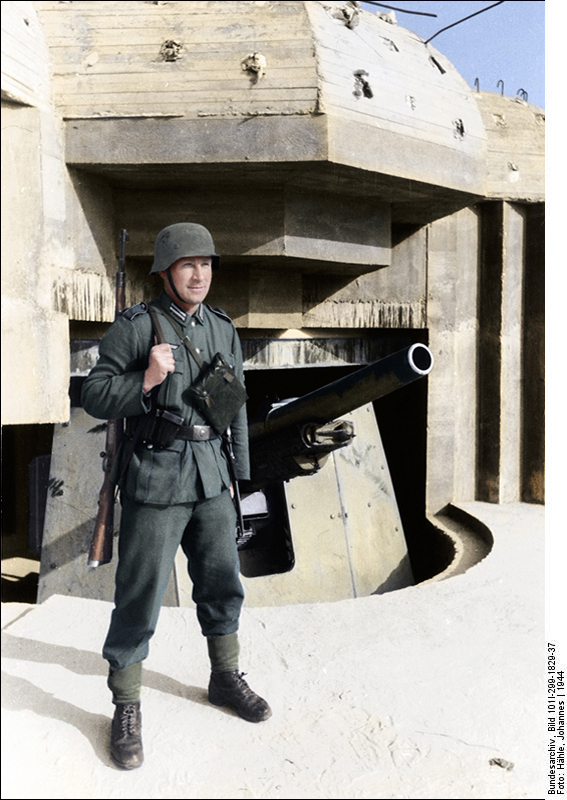
Preamble
In the 1920s, the German military struggled to pass out the restrictions of the Versailles Treaty, and in the new General Staff one service existed under the covert name of Truppenamt, having nine inspectorates including In-5, the Inspecktion der Pioniere und Festungen, responsible for modernizing fortification. This was still a thing in the interwar. Both France and Belgium modernized and expanded their own forts and the Maginot line needs no exposition. However in Germany, the need for fortification was relaunched as with only ten divisions, Germany simply could not defend its borders. Between 1920 and 1933, the German Defence Minister headed the Inspektion der Pioniere und Festungen, and the Weapons Office which developed the new system of interwar German fortifications.
After Hitler came to power were created the Inspectorate of the Eastern Fortifications and Inspectorate of the Western Fortifications. The first was responsible of modernizing naval fortifications. Work was done at the Heilsberg Triangle in 1931 and reinforcement of the Samland Fortress in 1932, from Königsberg front to the Lötzen Stellung, mostly against Polish land incursions. But the major works were on the Pomeranian line, notably wit water obstacles and concrete ‘Dragon’s Teeth. New bunkers were built with a classification from A to D acording to their strenght, but they only housed smaller guns. The whole standardization effort is notably found on the Panzer Atlas. Most heavy work was done in concrete with however steel components, the Beobachtungsglocken (observation cloche) Dreischartenturm (three-embrasure half-cloche) and Sechsschartenturm (six-embrasure cloche). At this stage, new methods for pouring concrete and the use of rebar were developed, notably by what became the organization Todt.
Naval fortifications in this atlas were marked by the prefix “V”. All these laid up the ground work for future installations of the Atlantikwall in WW2.
We will go back on riverine fortifications of the 3rd Reich in 2026.
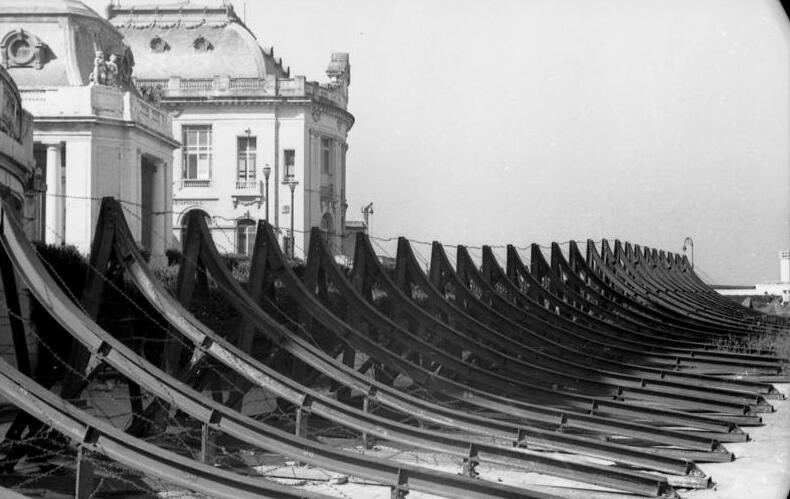
Interwar Naval Fortifications
Regelbauten (standard design) were developed in the later interwar to integrate the Unterstände (Personnel or Munitions Shelters/Garages for guns), Gefechtsstände (Command Posts), Nachrichtenstände (Communication Centres Radio, Telephone, or Radar), Beobachtungsstände (Observation bunker of Infantry or Artillery or Fire Control for Artillery or Flak) and Kampfstände, wich were the main combat types for infantry and artillery. “V” prefix for the Krigsmarine was classed as an auxiliary. Strnght gradation went from the 100 to the 500 series, and they appeared in the Atlantic Wall. The 200 and 300 were mostly of Kriegsmarine types, the 400 series Luftwaffe types. In 1942 the 600s series included positions for 75mm guns and larger calibre while the 500 and 600 series could mount antitank guns larger above the 37mm caliber, reserved to the 100 series. Older defensive forts of coastal cities moslty received radars and FLAK but not much more. No serious attempt was done to work on heavy gun defense there.
Cuxhaven:
During WW2 the old “Fort Grimmershörn” continued to be used for coastal defense with four quick-loading cannons model 10.5 cm SK/C 32 U, the same used on German submarines, plus a light infantry gun 7.62 IKH 290 and one 2 cm Flak 29 Oerlikon on pedestal mount 40. There was also the four 15.5 cm K 418(f) Kanonenbatterie Altenwalde, MAA 2/114 Batterie Hossfeld in 1944 with three 24 cm. KM 02/06 (f) model on C 42 mount and turret erected in 1944. Next was MAA 3/114 Von Sotch with three 15 cm SKC/28 in Kst.MPL C 36 (according to BAMA) and one 15 cm SKC/28 in an open construction. The MAA 4/114 Hipper comprised four 15 cm SK/L 35 guns and two 8 cm MG34 for close combat. M.FLAA 214 was FLAK fort, comprising notably the Scheinwerfer-Abteilung.
Fort Kugelbake, built 1869-1879 was modernised until 1911 and received a flak battery with four 10,5 cm guns on top of the fort in 1939 but saw little action and was taken over by British forces on 8 May 1945. Also at Geestemünde on the Weser and protecting Bremerhaven was located the most critical North Sea base of the Kriegsmarine. FLAK posts were erected on the old forts, but not much more.
Wilhelmshaven
The port was defended by batteries along the western shore of the Jade, so placed as to sweep the very narrow fairway. The heavy guns, said to be of 9.4-inch and 8-inch caliber, were in armored cupolas, the position of which was invisible from the sea. There was also a shore torpedo station and a mine depot. This was still also the standing German naval port for the Kreigsmarine surface craft and submarine base, both were heavily defended, as was a Kriegsmarine construction yard and base offering direct access the Atlantic. The Luftwaffe in the first year of the war had an airfield and two squadron to defend the area against considerable RAF Hampden and Wellington daylight raids. Apart FLAK posts on former forts, the port ws also heavily defended by flak ships, all using a radar from 1944.
Borkum
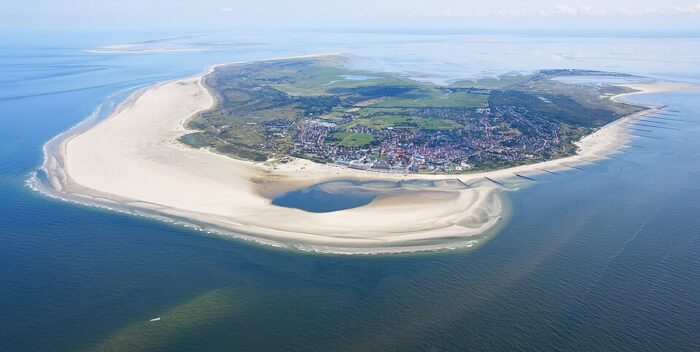
The fortress of Borkum was to cover the naval base of Emden and provide flank protection for warships leaving from there or Wilhelmshaven. It denied anchorages near the island or even to use it as a bridgehead for a future landing. Indeed Churchill planned a landing on Borkum in WWI but after the defeat of the Dardanelles this plan was denied. In the interwar, the fortress was further expanded with some 5,000 soldiers stationed on the island. Wernher von Braun made tests there in 1934. In 1944 this was a test base for the Molch midget submarine.
Helgoland:
The island was demilitarized in 1920 but in 1937, construction started on a major reclamation project (Project Hummerschere) to expand existing naval facilities and restore the island, notably for areas eroded by the sea, however it was largely abandoned after the start of World War II, never completed. But work resumed later in the war, notably after an RAF raid, and the island was had its defenses completed and ready for use, like the submarine bunker North Sea III, coastal artillery, an air-raid shelter system with extensive bunker tunnels. It was also a base for the Jagdstaffel Helgoland active from April to October 1943. In 1945 the RN detonated 6,700 metric tons of explosives in “Operation Big Bang” to destroy all these installations in one go.
Atlantic Wall: History
The Atlantic Wall (Atlantikwall) was an extensive system of coastal defences and fortifications erected from 1942 to 1944 along the coast of continental Europe and Scandinavia todeter or slow down any Allied invasion of Nazi-occupied Europe, especially from the United Kingdom. Manning and operation was overseen by the German Army, with support from Luftwaffe personal and assets. The Kriegsmarine had a fully separate coastal defence network included sea defence zones, ports and naval bases and concentrated on these. However they obeyed to the set regulation and standard book abou all constructions.
Hitler ordered these fortifications in 1942 through the Directive No. 40. This trigerred probably the largest construction effort of the war, with more than half a million French, Dutch, Belgian and Norwegian workers drafted to build a wall to rival the great wall of China, from the Arctic circle to Spain. Given the effort, it was frequently mentioned in Nazi propaganda and its strenght greatly exaggerated. There were indeed in some places some truly colossal coastal guns and many batteries, mortars, machine gun nests, and artillery was procured from occupied countries for the most, which meant ammunition supply was limited to a single day action or less than an hour in many cases. Ruins of the wall still exist today in all nations concerns, but most had fallen into the ocean due to erosion and many were reclaimed by marine life or were demolished over the years, an other preserved and turned into museums. The only land equivalent was the Westwall (In particular the Siegfried Line), which was also strong enough to slow down the US Army and inflict tens of thousands of US casualties in the Hürtgen Forest over 88 days. In contrast, the fabled Atlantickwall just resisted a mere few hours.
Root Causes
Prior to the decision to create the Atlantic Wall, UKsince the summer of 1940 was considered already ou of the war, before giving a bloody nose to the Luftwaffe, and by the winter, it was clear the island nation would not fall not ask for peace. Instead, war now turned to the sands of Africa, and giving a bloody nose to the Italians, than needed rescue in 1941. Meanwhile, there was a serie of limited commando raids on the coast, and on 2 June 1941 Adolf Hitler asked for maps of the Channel Islands in order to prevent any traffic there. The latter were indeed an interesting case.
Churchill, given their remote location and the lack of resources, decided to left them to their own fate, and following the fall of France, they were invaded and occupied by German troops (the only part of britain ro experience German occupation until 1945). By their strategic location, they potentially commanded naval passage to the Bay of Biscay and it soon appeared useful to have them armed and fortified, notably with long range artillery. On 13 June more men were sent there as the defence was seen as inadequate, without tanks to repel an invasion or coastal artillery. Soon, the Organisation Todt (OT) was instructed to create there some 200–250 strong points on each of these islands, and plan submitted to Hitler was further reinforced on 20 October 1941, and after the conference on 18 October the fortifications were created and completed within 14 months with Festungspionierkommandeur XIV created to command the project.
Six months later, on 23 March 1942 Hitler issued the Directive No. 40 for the creation of an “Atlantic Wall”, based on what was achieved by Todt on the Channel islands. He ordered also naval and submarine bases to be heavily defended and the project started with ports until late 1943, then increased in other areas. Todt in betwen requested for massive supplies of cement, steel and armour plating, which needed to be transported.
The Regelbau
The Regelbau (“standard build”) was a system od standardization to ensure the entire wall was built with efficience, with everything coded, planned, and built in large scale. There were over 600 approved types of bunker and casemate with their dedicated purpose, with even prototypes destroyed to verify their effectiveness. Lower in this article, these are detailed. Standard features was a single entrance door at right angles, an armoured air intake, 30-millimetre (1.2 in) steel doors as well as ventilation systems and telephones. The internal walls were lined with wood and there was also always an emergency exit system and many items. In all, 200 standardised armour parts are referenced alone, notably “bells” in a lesser-grade steel and iron acting as turrets. There was indeed a competition for high grade steel, reserved for the production of Tanks. This standardisation simplified manufacture and control, supply under budgetary limits, and speed of construction, at least on paper as the whole organization was streamlined. Shortages meant as much as captured equipment were incorporated in the defences and casemates, with many posts of non-German artillery as well as anti tank and machine guns, obsolete tanks turrets. Some already had been used with success in the defence of tobruk as pill boxes (“tobruk pits)”.
Organization Todt’s work
Organisation Todt (OT) was formed in 1933 when Hitler came to power. It was a conglomerate in the Soviet style, and was tasked of large civilian engineering construction projects, starting with the famous Autobahn. The company’s engineers laso started work prior to the war on the Siegfried Line along the Franco-German border and became naturally the chief engineering group to design and built the Atlantikwall major gun emplacements and fortifications, whereas minor works were left to local companies, provided they obeyed to the Regelbau’s strict norms.
OT supplied both supervisors and labour, but also oversaw the logistics, supply and machinery, all matter of equipment as well as relations to sub-contractors. Indeed this was a (mostly forced) European effort, with a German core but construction companies in occupied countries that bid for contracts and benefited greatly from these. Most were free to participate but some were conscripted, but those whoch failed to reach their deadlines could be sanctioned or even forcibly closed down, then taken under direct supervision of OT, or merged with another firm jusged more trusted, more efficient. The oens that were successful made attractive profits however, something tht was put into question when peace returned.
OT obtained many quotes for everything related to the construction locally, signed contracts with these companies and chose the price and terms of the contracts, including bonus payments for efficiency, but also imposed wage rates and bonus for workers depending on nationality and skill. The Labour behind the Atlantikwall is still a controversial subject studied to this day. It was a mix. There were skilled volunteers, many nationals, as well as engineers, designers and supervisors, which can be from local companies provided they proved their competence, paid and treated well, but lowed in the scale, there were volunteers, skilled technicians and artisans (carpenters, plumbers, electricians or metal workers) pkaced under the same regime as any German OT worker. But Next came was a mostly “anonymous” mass of unskilled forced labour on the lower step, paid poorly, treated harshly and mostly conscripted and forced, many being former POWs (like returned French POWs), then slave labour, seleted from concentration camps or POW camps, often Russians or Poles. But some could escape harsher treatments by volunterring to join OT training courses to improve their skills.
In any case, givenn the scale the works required, these were massive numbers of workers. The Vichy regime to provide for this, took the initiative to impose a compulsory labour system and managed to provide 600,000 French workers to construct permanent fortifications as far as the Dutch and Belgian coasts. But manpower was badly needed in Germany too and thus, manpower quality dcreased from late 1943 to late 1944, aggravated by fuel shortages and bombing. V-weapons sites were partticularly targeted by the allies, and volunteer workers just refused to work there, or at gunpoint.
OT Cherbourg was probably the largest of all sub-organizations, as indeed this was the most likely spot for an allied invasion, and by January 1944 it dealt with 34 companies and 15,000 workers plus 79 sub contractors. Everything was noted and quantified, then reported to Berlin, then condensed for Hitler that still followed it closely.
Bu this construction of course suffered at first British attacks, and if 1942–43, the Atlantic Wall was a quiet front seen as a promotion for the Wehrmacht after their efforts on the eastern front, only two operations took place, Operation Chariot, the famous raid on St Nazaire of March 1942 that destroy German pumping machinery and the Normandy dry dock and installations. The second attack was the Dieppe Raid in August 1942, a mostly Canadian landing test of German defences. Despite the presence of tanks, bogged down in the terrain this was a crushing defeat with heavy casualties. Hitler only was confirmed in his fear of an Allied invasion and pressed Marshal Gerd von Rundstedt to mass 15 further divisions to repel it. The Atlantic Wall was also reinforced.
Rommel and the 1944 reorganization
The Allied invasion grew more likely in 1944 as an intense intel operation (Fortitude) and a double cross spying operations convinced the German of an incoming landing in the Pas de Calais. Field Marshal Erwin Rommel, axhausted and badly ill after the north African campaign, had all the trust of Hitler and was reassigned to evaluate improve the wall’s defences. He started by a long tour from Bordeaux and the southern French coast up to the Netherlands and consiered allpreparations were woefully inadequate. He started to strengthen them, based on his personal experience at Tobruk and the Mareth line. His main concern was Allied air power, also an experience of North Africa, notably that the panzerdivisions held in reserve and leading a counterattack would be broken up by aviation, without efficient support of the Luftwaffe. So defeating the allies on the beach was imperative. He ordered hundred of concrete pillboxes to be built on the beaches and slightly inland to house machine guns as well as antitank guns, light and heavy artillery, instead of the focus of coastal artillery that was maintained until then. He also placed millions of land mines of new models not detected by magnetic-based systems, and erected tens of thousands of antitank obstacles on the beaches, some to sunk or disable incoming landing craft at high tide, others to stop the progression of tanks. Many underwater obstacles also had explosive charges and a detonation trigger, but also he obtained all the naval mines remaining in Kriesgmarine stocks to be planted just offshore. He also obtained tens of thousands of extra troops, mostly from POW camps, including many Russian minorities.
Atlantic Wall: Port Command
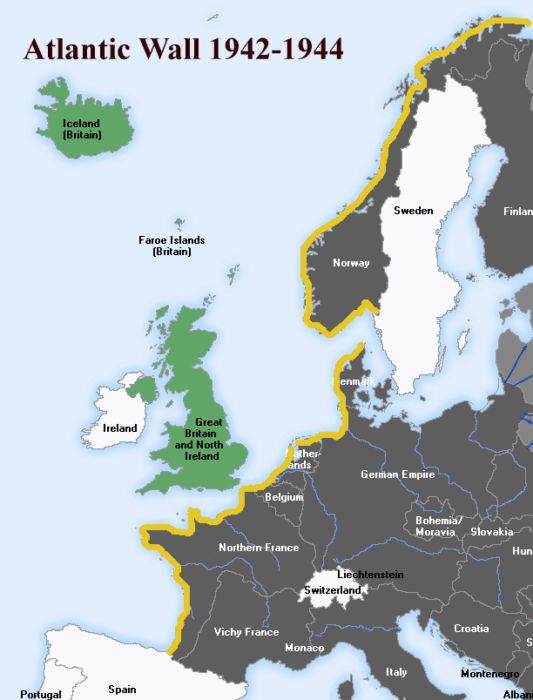
Later, with the conquest of the low countries, Denmark, France, a massive new frontline was secured close to the last western power still standing. The opportunity was to base their ships and submarines, shortening considerably their travel time to the Atlantic. It became a concern soon also to defend these new bases. Everybody remembers the U-Boat pens in Lorient. In their final form, they were bomb-proof, apart perhaps for the exceptionally large barnes wallis “bunder-buster” models, but they were in short supply. To quell incessant raids, these new German bases in occupied Netherlands, Belgium and France, but also Norway. These later became anchoring point for the Atlantikwall defenses. At first these were Aalesund, Alta, Andalsnens, Arendal*, Bergen*, Bodö, Brevik, Brönnöysund, Drontheim, Egersund, Farsund, Flatöy, Hammerfest, Hamnbukt, Harstad*, Haugesund, Honningsvaag, Horten*, Kirkenes*, Knarrevik, Kopervik, Kristiansund*, Larvik, Lervik, Lödingen, Maalöy, Mo, Molde, Mosjöen, Namsos*, Narvik, Oslo*, Petsamo, Rörvik, Sandnessjöen, Stavanger*, Svolvaer, Tromsö*, Vadsö and Vardö on Norway (starred ports were the largest) with Haugesund and Kirkenes being local naval command for their respective regions. All these were under administrative responsibility of the Kriegsmarine.
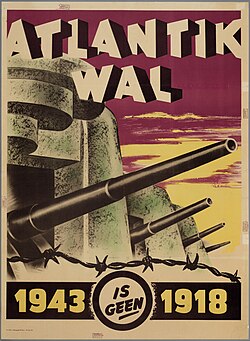 In the Netherlands, these were Amsterdam, Antwerpen, Den Helder, Hoek van Holland, Ijmuiden, Rotterdam and Vlissingen and as secondary bases, Harlingen and Groningen. In Belgium these were Nieuport, Ostende and Zeebrügge, also all major bases. In France, the list was also impressive, going all the way to the Spanish border: Arcachon, Bayonne, Bordeaux, Boulogne, Brest, Caen, Calais, Cherbourg, Dieppe, Dünkirchen (Dunkirk), Fécamp, Granville, Gravelines, Honfleur, La Pallice, La Rochelle, Le Havre, Le Tréport, Lorient, Marseille, Morlaix, Nantes, Port de Bouc, Port Vendres, Rochefort, Rouen, Sète, St. Nazaire and Trouville were considered major bases, and there were smaller ports most on the French riviera after Operaton Lila in November 1942: Cannes,
In the Netherlands, these were Amsterdam, Antwerpen, Den Helder, Hoek van Holland, Ijmuiden, Rotterdam and Vlissingen and as secondary bases, Harlingen and Groningen. In Belgium these were Nieuport, Ostende and Zeebrügge, also all major bases. In France, the list was also impressive, going all the way to the Spanish border: Arcachon, Bayonne, Bordeaux, Boulogne, Brest, Caen, Calais, Cherbourg, Dieppe, Dünkirchen (Dunkirk), Fécamp, Granville, Gravelines, Honfleur, La Pallice, La Rochelle, Le Havre, Le Tréport, Lorient, Marseille, Morlaix, Nantes, Port de Bouc, Port Vendres, Rochefort, Rouen, Sète, St. Nazaire and Trouville were considered major bases, and there were smaller ports most on the French riviera after Operaton Lila in November 1942: Cannes,
La Ciotat, Le Tréport, Les Sables d’Olonne, Lezardieux, Nizza (Nice, shared with the Italian command before sept. 1943), St. Louis de Rhone, Royan, St. Malo and St. Tropez. Bordeaux was also an odd case, as it was the siege for the Italian naval command Atlantic (BETASOM) sharinf the burden of submarine warfare in the Atlantic.
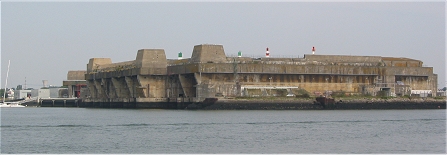
Lorient’s Keroman pens. In all 44 submarine pens to shelter 4 flotillas were built between 1940 and 1942. To defend them from naval bombardment, at the neck of the Quiberon peninsula, close to Plouharnel a formidable battery was created there, easily the most powerful artillery sites in the Atlantic Wall. Thes eformer French battleships 340mm guns received new cradles and had a final range of 38km, so to interdict a large passage aea off the coast of Bretagne and access to the Gulf of Morbihan. Their arc of fire linked up with that of the 240mm guns battery at Batz, 60km down the coast, then covered by the battery protecting St. Nazaire Submarine Base.
Of course, all these ports were targeted by RAF raids, notably the largest, which notably contained major logistical assets. St. Nazaire was the only naval yard with drydocks large enough for a Bismarck class battleship, leading to a daring raid. There were also occupied harbour important for the war in the Mediterranean and often forgotten, in the Black Sea and Aegean sea. Also after Italy asked for an armistice in September 1943, Germany occupied many new ports, offering them another Italian, Albanian, and Dalmatian coastline to exploit and defend.
There were also new Baltic states ports of the former Latvia, Lithuania, and Estonia under command of the Hafenkommandanten im Bereich des Admirals Ostland, and the special military areas of Riga and Reval.
All these ports needed at least a few FLAK installations, but heavy guns for coastal defenses were few and far between. Defences, especialy against allied raids, were very consistent for the main French submarine bases, Brest, Lorient, St-Nazaire, La Pallice and Bordeaux. All received concrete pens as passive defences while FLAK defence was really consistent. Luftwaffe units at nearby airfields were prepared for interception. however as the eastern front consumed more of these, on D-Day in June 1944, the skies were famously “own” by the allies.
On that matter of heavy guns, the French 340mm/45 Modèle 1912 of the Bretagne class had been converted in WWI for railroad use at the end of the war, but the ones planned for the cancelled Normandie class, 12 in all, were converted by Schneider as railroad guns from the start. They prety much spent the entire stock of ammunition that was planned for the dreadnoughts already. Six more were converted by St.Chamond as “Canon de 340 modèle 1912 à berceau” using a hydro-pneumatic cradle system. They all ended on the most strategic points along the French nortgern coast, part of the Atlantikwall. However 3 St Chamond were apparently offered to the Italians to defend key Med bases such as taranto, albeit they were never deployed.
Atlantic Wall: Kriegsmarine’s Bunkers
100 series
120 Leitständ für Seezielbatterien
123 Maschinenhausm
132 Leitstandm
145 Auffüllraum für 12,7-17 cm Munition
150 Leitstand
151 Bereitschaftsraum für 1/2/24
152 Marine-Artilleriekommandostand
157 Leitstand mittlere & schwere Batterien
158 Bettung für leichte Geschütze
159 Gefechtsverbandplatz
160 Unterstandm
162 Leitstand für leichte Seezielbatterie
163 Maschinenzentrale für Mittelbatterien
170 Geschützschartenstand 150mm 90°
172 Seekommandantenstand in B
176 Geschützschartenstand 120°
180 Geschützbettung für Mittelbatterie 17 cm SK L/40
182 Seezielleuchtstelle
183 Maschinenzentrale
184 Geschützstand für 15 Cm SKL/28 in Drehturm
200 series
262 Leitstand für leichte Seezielbatterie
263 Leitstand für mittlere Seezielbatterie
270 Geschützschartenstand 150mm 120°
271 Geschützschartenstand 120°
272 Geschützschartenstand 120°
283 Maschinenkleinunterstand
300 series
383 Einheitsmaschinenraum
S series
S100 Leitstand für Schewere Batterie
S262 Turm für 406 Sk C/34 Lindeman 40,6 cm
S414 Leitstand für schwere Batterie
S446 Leitstand für schwere Batterie in B
S448 Turmleitstand für schwere Batterie in A
S448a Auffülraum für 24-40,6 cm Munition
S449 Peilstand für mittlere und schwere Batterie
S468 Auffülraum für 24-40,6 cm Munition 2 Geschosse
S497 Hochleitstand für schwere Batterie in B
S498 Auffülraum für 15-30,5 cm Munition
S504 Auffülraum für 24-40,6 cm Munition
S548 Auffülraum für 38 cm Munition 2 Geschosse
S561 Doppelgeschützturm für 38cm SKC/34 Geschütz
S611 Stand für 28 cm Sk C/34
S741 Bettung für das Schießgerüst C/41
V series
V174 Unterstand für Funkmessgerätmv174/01s.jpg
V189 Mittlere Funkempfangsstelle in B
V193 Ortungszentrale
V194 Fernmeldeknotenpunkt
V196 Befehlsstand
V256 Unterstand für Maschinensatz für Scheinwerfer G200
V297 Unterstand für Maschinensatz für Scheinwerfer G150K
FL242 air defence bunker
Leitstand für leichte Seezielbatterie: Searchlight, ammo stores, accommodation for a crew 8-9, armed with a 2cm Flak 30/38/Flakvierling.
Il will come for more detail in the future, for all if available somewhere.
OB 21
Called the Offene Bettung mit Bereitschafstraum und Munition. It was 21.10 m long, 14.4 m wide and 2.9 m tall with an average thickness of 40-50 cm reinforced concrete.
More on the OB 21
Radars
B-Werke
B1-1 MG-Schartenstand
B1-1a MG-Schartenstand Eingang rückwärts
B1-2 MG-Schartenstand mit Gruppe, flankierend
B1-2a MG-Schartenstand mit Gruppe
B1-3 MG-Schartenstand mit Kleinstglocke
B1-4/I MG-Schartenstand mit Kleinstglocke und Gruppe
B1-4/II MG-Schartenstand mit Kleinstglocke und Gruppe, flankierend
B1-5 Doppel MG-Schartenstand
B1-5a Doppel MG-Schartenstand
B1-6 Doppel MG-Schartenstand mit Gruppe
B1-7 Doppel MG-Schartenstand mit Kleinstglocke
B1-7a Doppel MG-Schartenstand mit Kleinstglocke
B1-8 Doppel MG-Schartenstand mit Klein
B1-10 MG-Schartenstand mit Gruppe u Deckenplatte, flankierend
B1-10a MG-Schartenstand mit Gruppe u Deckenplatte
B1-11 MG-Schartenstand mit Kleinstglocke
B1-12 MG-Schartenstand mit Kleinstglocke, Deckenplatte, flankierend
B1-12a MG-Schartenstand mit Kleinstglocke, Deckenplatte u Gruppe
B1-13 Doppel MG-Schartenstand mit Deckenplatten
B1-14 Doppel MG-Schartenstand mit Gruppe (Deckenplatten)
B1-15 Doppel MG-Schartenstand mit Kleinstglocke (Deckenplatten)
B1-16 Doppel MG-Schartenstand mit Kleinstglocke u Gruppe
B1-17 MG-Schartenstand mit Nebenaufgabe u Gruppe
B1-18 Pak-Schartenstand 60°
B1-18a Pak-Schartenstand 30°
B1-19 Pak-und-MG-Schartenstand 60°
B1-19a Pak-und-MG-Schartenstand 30°
B1-20 Pak Unterstand mit MG-Schartenanlage
B1-21 Pak Unterstand mit Kleinstglocke u MG-Schartenanlage
B1-22 Kompanieführer-Stand mit MG-Schartenanlge
B1-23 Stand mit Dreischarten-Panzerturm
B1-24 Stand mit Dreischarten-Panzerturm u Gruppe
B1-25 Stand mit Sechsscharten-Panzerturm
B1-26 Stand mit Sechsscharten-Panzerturm u Gruppe
B1-27 Bataillonsgefechtsstand mit MG-Schartenanlge
B1-28 Artillerie-Beobachtungsstand
B1-28a Artillerie-Beobachtungsstand mit MG-Schartenanlge
Unterteilen
1ML4 Schutzlüfter HES 1,2
1ML4 Schutzlüfter HES 2,4
20P7 Sechsschartenturm
21P7 Panzerturm
403P9 Stahlschartenplatte für MG
407P9 Panzer-Turm mit 3 Scharten für MG
420P9 Stahlring für FN Gerät
434P01 Stahltür
491P2 Gittertür für Zugänge
49P8 Panzerturm für M19
4ML01 Überdrückventil
7P7 Stahlschartenplatte für MG
726P3 Stahlvorsatzplatte für 7P7
81P9 Pantzertrurm für leichte Turmhaubitze
90P9 Kleinstglocke für Infanterie Beobachtung
924S4 Bett mit Staldrahtmatratze
WT80 Festungsofen
WT80K Festungsofen mit Kochplatte
Stahllüftungsschacht 12 cm
Stahllüftungsschacht 15 cm
Stahllüftungsschacht 20 cm
Stahllüftungsschacht 30 cm
Atlantic Wall: Locations
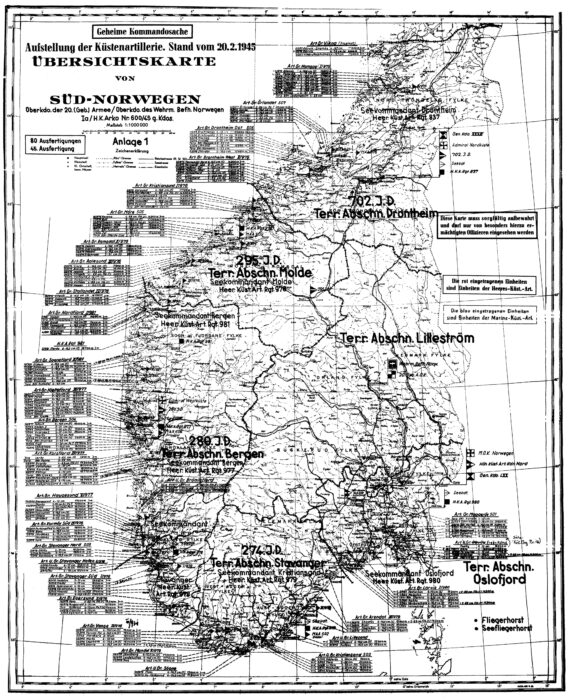
HD Map of Norwegian fortifications
Norway
ArtObGr 8 Senja HKAR 972
ArtObGr 7 HKAR 983
ArtObGr 6 Westlofoten
ArtObGr 5 Lødingen MAR 30
ArtObGr 4 Molde-Trondheim
ArtObGr 3 Bergen
ArtObGr 2 HKAR 978
ArtObGr 1 HKAR 980
Denmark
Jutland-Nord
Jutland-Central
Syddanmark
Sjaelland
Bornholm
Germany
Westerland
Westerhever (Augustenkoog)
Cuxhaven, Bremerhaven, Whilhelmshaven, Borkum (see above)
Wangerland
Schweinfurt
HuMG Hornisse, V1, V2 Feuerstellungen commands
Netherlands
WB deutsche Bucht
WB Niederlande
AOK 15/KVA 15
Belgium
AOK 15
Innere Festung Belgien
France
AOK 15
AOk 7
AOK 1
Innere Festung Frankreich
Atlantic Wall: Standardized Parts
Unterteilen
As for artilly batteries, from the North Cape (Norway) down to the Spanish border, counting anything from 105 mm to 406 mm there were over 800 batteries, supplemented by 250 batteries from 75 mm to 90 mm and FLAK.
Atlantic Wall: The great test of D-Day
When the main Allied invasion took place on 6 June 1944, preceded by a year of preparations and deception operations, the Germans had laid almost six million mines in Northern France and more gun emplacements and minefields were extended inland along roads leading away from the beaches to compensate for the lack of manpower. It was therorized that the two panzerdivision stationed at the rear of the Pas de Calais area would intervene in the matters of hours to crush any bridgehead. In likely landing spots for gliders and paradroppings, slanted poles with sharpened tops (Rommelspargel or “Rommel’s Asparagus”) were also implanted. In Normandy but in other places as well, Low-lying river and estuarine areas were intentionally flooded. Rommel believed any invasion had to be stopped right on the beach, as it would be too late and that the first 24 hours of the invasion would be decisive. The post here is not devoted to the Landings in Normandy, as the subject has been well treated already in the allied amphibious operations page, and there are tons of content alread on the internet. But in this ultimate test, even the less well defended Normandy beached inflicted 10,000+ casualties with 4,414 confirmed killed and the loss of 185 M4 Sherman tanks alone (mostly the infamous Duplex-drive types) while the Germans had 4,000–9,000 killed, wounded, missing, or captured over a total of 50,350 men in this sector and 170 coastal artillery guns. The allied deployed that day in two waves, 156,000 soldiers, helped by 195,700 naval personnel, and the largest fleet ever assembled in history. Hitler famously was not awakened, and the Panzerdivisions which needed to be sent asap were considerably delayed, and massacred by allied aviation underway. If the Atlantikwall barely held for a day, on some sectors it proved quite efficient like at Omaha beach where casualies were indeed considerable with a ratio largely in favor of the defenders, and it was due to a navigation error. Allied bombing had been largely inefficient. The paradox is that the campaign was soon boddeg down in “natural defences”, the infamous hedgehog, combined with skilled German troops, adept of counter-attacks. As said above, the Siegfried line held for almost 100 days, helped by the forest.
The Channel Island and last strongholds
The Channel Islands were heavily fortified, being Hitler’s trophy be default of having consuered Britain after the Luftwaffe failed in the air battle and cancellation of Operation Seelowe. Alderney, closest to Britain was the most densely armed and fortified of all islands, so much so that Hitler decreed that one-12th of the steel and concrete used in the Atlantic Wall should go to the Channel Islands alone. They had for home a strong propaganda value and became a network of Hohlgangsanlage tunnels, casemates, and coastal artillery positions, wich mostly survived to this day, some renovated, some supporting the test of time. Alas, the Allies bypassed them on D-Day and the garrisons only surrendered by 9 May 1945, and the one on Alderney on 16 May. They are still among the best preserved of the Atlantic Wall.
Gallery
Read More
https://commons.wikimedia.org/wiki/Category:Atlantic_Wall
fortiff.be regelbau Kriesgmarine Fortifications index, 100 to V series
https://bunkersite.com/locations.php
prussia.online forts and fortifications of europe 1815-1945 Kaufmann Pen & Sword
festungswerke-cuxhaven.de
forum.axishistory.com/ main fortif.
forum.axishistory.com/
battlefieldsww2.com gun battery plouharnel
sudwall.superforum.fr/
Scandinavian Fortifications
Sweden’s naval fortifications
Fort Frogn Kaholmen, Oscarborg
In 1901 was created the Kustartilleriet, born from traditionsgoing back to the old coastal fortresses in use around Sweden since the 15th century. The command structure subordonated until then to the fortress artillery department. This became an independent branch, starting with the Vaxholm Artillery Corps in 1889. Both coastal defence fortresses and city fortresses were formerly under command of Artillery branch. But with the arrival of the fixed mine defence units the question of an independent branch returned to manage both mines, torpedo and artillery in coastal fortifications, ending with the constitution of the Coastal Artillery in 1902, the fusion of the Vaxholm Artillery Corps, Karlskrona Artillery Corps and fixed mine defence units.
Reforms were numerous but mostly followed a simple rule: Early fortifications were created in the 14th-16th centuries for self-governed provinces and later as Sweden became independent, redundant forst were simply closed and decommissioned. Among these were the oldest, like Bulverket, Visborg and Vyborg Castle, the latter deactivated as embedded in a dense urban landscape. In the tense 17th Century and conflict with Russia, the Kalmar war and 30 years war, New Älvsborg was rebuilt, Carlsten, Dalarö, Gothenburg, Karlsvärd, Kastellet, Nyenschantz, Skansen Kronan and Skansen Lejonet and the Varberg Fortress was ebuilt to new standard of artillery and as star forts. In the 18th Century, Sweden concentrated on new modern fortresses like Suomenlinna and Svartholm.
With the cost of new technologies to assume in the XIXth Century, Fårösund, Karlsborg, Vaberget were built and Vaxholm rebuilt. The last fortifications were erected in the early 20th century: The Boden Fortress, Femöre battery, Järflotta, Kastellet (rebuilt, definding stockholm) the Skåne Line and the Älvsborg Fortress. Reforms were applied to the Swedish Coastal Artillery, and now this patrimony is managed by the Swedish Fortifications Agency. The largest of these was the Skåne Line, erected in WW2 against both Germany and USSR. It was called the “Maginot line of the north” and comprised some 1063 fortifications. The last were discarded in 1990.
Norway’s naval fortifications
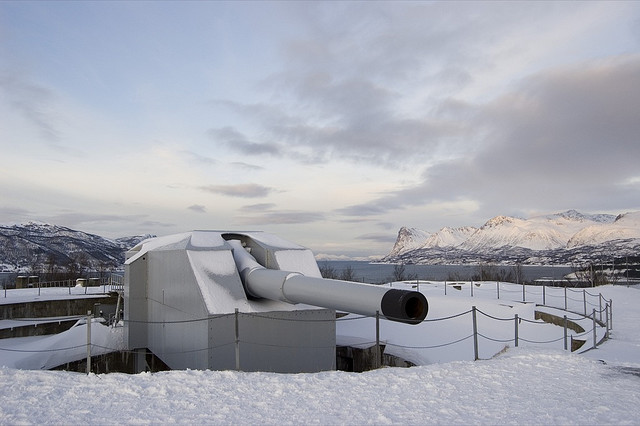
40,6 cm Adolph gun at Harstad Battery
With numerous narrows and fjords, Norway was almost impossible to attack by sea and the topography naturally the best place to install fortresses, since 1600, with perhaps the oldest being Akershus Fortress in Oslo. All major ports were towered by their own fortress and artillery battery. With time, artillery positions were installed alongside Fjord entries, well hidden in the landscape. From the XVIth to the XIXth centuries, new constructions were done more specifically to interdict fjords: Fredriksberg, Fredriksholm, Fredriksta, Fredriksværn, Kongsvinger, Basmo, Blaker, Christiansfjeld, Munkholmen, Staverns, Christiansholm, Christiansø, Kristiansten, Altenhus Fortress.
With modern lighting and lectric power a new generation of modern fortifications appeared in the late XIXth century to the 20th century. They will be covered more in detail as contrary to Sweden, these would play an important wartime role with the German invasion: Operation Weserübung:
Hegra Fortress (1908-10):
Built to block Swedish advances into Central Norway: 2x 7.5-cm (3.0 in), 4x 10.5-cm (4.1 in) in pits. Reserve WWI, deactivated 1939.
Helgøya Fortress (1942):
German-built fort to protect coastal traffic and the west entrance to Kristiansand. 4x 10.5-centimetre (4.1 in) coastal artillery.
Kvarven Fort (1895-1902):
Built to defend Bergen harbour and naval installations at Marineholmen and Wallemsviken. The fort was completed in 1899 with four 21 cm St. Chamond cannons and three 24 cm St. Chamond howitzers, three 75 mm QF guns and two machine guns. Later was installed a torpedo battery, fired from above ground. This positions was shelled by the cruisers Königsberg and Köln and assaulted by 1900 troops during Operations Weserübung on April, 9, 1940.
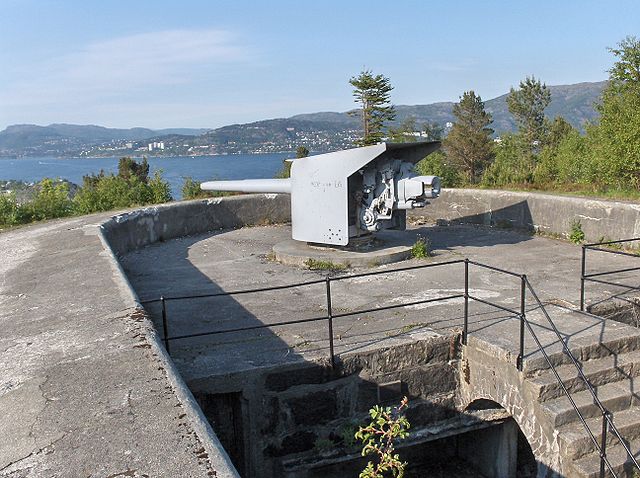
Kvarven Fort, June 11, 2006
Odderøya Fortress (1815):
It was situated on a natural island which creates a division between the eastern and western parts of the port of Kristiansand. This strategic post was attacked by sea, with KMS Karsruhe (which was hit by its defense), the Luftwaffe and 2000 men by land.
Oscarsborg Fortress (1846):
Certainly the most famous. Built in Drøbak Sound, Oslofjord, and thus protecting the entry to Oslo harbor in natural narrows, it was preceded by another fort dating back to 1644, and was rebuilt and modernized the last time from 1890. This “uninkable battleship” had three Krupp 28 cm (11 inch), batteries of 15 cm and QF 57 mm, two underwater barriers and a torpedo battery, dating back from 1890. It was kept “in its juice” until 1940. Unknown the Germans there was also an underground torpedo facility built in 1898–1901. The torpedo battery wasn encased in a concrete construction, inside a natural cave, on the north Kaholmen island. Two torpedoes turbes side by side in open steel frames could be lowered lowered like an elevator, down into the water. The battery has three torpedo tunnels and thus could six torpedoes without reloading, nine torpedoes being stored, made ready for use, with a 100 kg TNT warhead. Targeting was done from three observation bunkers above the battery. The Fort played a vital part in the defense of Oslo at the Battle of Drøbak Sound, by sinking the heavy cruiser Blücher at the head of a convoy. This was the most serious loss of the Kriegsmarine for the whole campaign, except the destroyers savaged by HMS Warspite. This efficient defense, despite being 40 years old equipments, threw back the German naval force heading for Oslo and saved the capital for some time.
Trondenes Fort (1943):
Built by the Germans as part as the “northern atlantic wall”, in the Finnmark, and certainly the most potent close to Harstad. It was equipped by the largest coastal guns at the time, four 40.6 centimetres (16.0 in) Schnelladekanone C/34, also colloquially “adolf guns”, with a range of about 56,000 metres (35 mi).
Meløyvær Fortress (1983):
Basically among the very last naval fortifications in Europe: It defended the entrance of the Andfjorden from a possible Soviet attack. It cosisted in three turreted 120 mm Bofors guns. The whole installation was deactivated and turned into a museum.
Møvik Fortress (1941-44):
Built by the Germans as part of the northern Atlantic wall: This coastal artillery fortress on the Skagerrak was named Batterie Vara (MAB 6./502 Vara), armed by four guns, including a single 38 cm SK C/34 gun (same as a Bismarck class battleship). It was turned into a museum, now called the Kristiansand Cannon Museum.
Portuguese Naval Fortifications

Portuguese naval fortifications are a fascinating and globally significant legacy of Portugal’s maritime empire, which reached its height during the Age of Discovery (15th–17th centuries). These fortifications were built to protect strategic coastal points, ports, and sea routes in Europe, Africa, Asia, and South America.
Portuguese naval fortifications were primarily built for the defense of coastal settlements and harbors, the protection of trade routes and shipping lanes, control over key maritime chokepoints and deterrence against pirates and rival European powers.
There were common architectural Features such as thick stone walls, low profiles, bastions and angled walls (inspired by the trace italienne style) and cannon emplacements facing the sea watchtowers, cisterns, and storage facilities.
Key Regions and Fortifications:
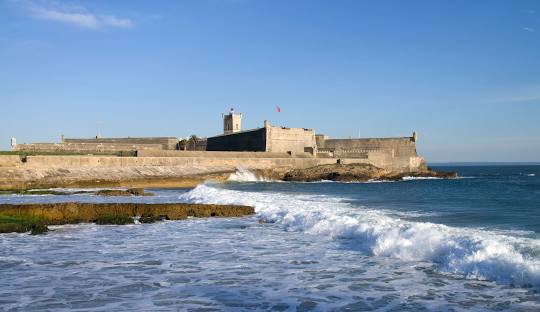
In Portugal the Belém Tower (Torre de Belém) in Lisbon remained a classic example, iconic of the city, UNESCO World Heritage Site; a ceremonial gateway and defense point on the Tagus River.
There was the Fort of São Julião da Barra at Oeiras, largest and most important military defense complex protecting Lisbon.
In Africa the Fortress of São Jorge da Mina (Elmina Castle) in Ghana stands out; It was built in 1482; one of the oldest European buildings in sub-Saharan Africa.
The Fort of São Sebastião on an Mozambique Island is the oldest complete fort in sub-Saharan Africa, begun in 1558.
Fort Jesus in Mombasa, Kenya was built in 1593–96 to protect trade routes in the Indian Ocean.
In Asia there was the Fort of São Tomé in Chennai (Madras), India, an early Portuguese settlement and trading post.
Fort Aguada in Goa, India was built in 1612 to protect against Dutch and Maratha invasions. And there are the Macau Fortifications in China, including Mount Fortress and Guia Fortress, essential in defending the Portuguese colony.
In South America there are seveal forst in Brazil, the Fortaleza de Santa Cruz da Barra, one of several coastal forts built to defend Rio de Janeiro (well preserved) as well as the Fort of São Marcelo at Salvador, a circular sea fort with Renaissance influence, defending one of Brazil’s key colonial ports.
These Portuguese forts formed a defensive maritime network connecting Europe to India, Southeast Asia, Africa, and South America.
Several are now protected as UNESCO World Heritage Sites.
Portuguese fort design influenced local styles and colonial architecture.
These forts played key roles in Portuguese colonialism, trade (especially spices, gold, and slaves), and missionary activities.
(More To come next)
Spanish Naval Fortifications

Spain in 1210 at the start of the final Reconquista
Spain did not lacked forts and fortresses but had few foes at sea justifying construction of coastal forts, that is until the Muslim arrived at the scene. The Moors succeeded to a fractured country previous ruled by the Visigoths. “Al Andalous” almost covered the entire contry at its greatest extension of the Umayyads in 720 BC. They were contained beyond the Pyrhenees by the powerful Carolingian Empire (battle of Tours) and by a narrow band of territory in the mountains, encompassing the Basque country: The Kindom of Asturias, capital Oviedo. The reconquista took centuries, and in 1200, the now Almohad dynasty only ruled half the country. The north was now divided between several kindoms (see map). The focus of Christian forces was not the sea, but to continue this reconquista until its term under Queen Isabella, with the fall of Algesiras, the last moor stronghold.
Spain, more united until the Crowns of Castille and Aragon (not forgetting nearby independent Portugal which started to capitalize on the sea), started to built a trade and military Empire, using notably a flurry of new warship innovations in contructions and soon exploiting the recent discovery of the Americas, an enterprise originally funded by Isabella and Ferdinand and led by Cristobal Colon. From there, development of naval fortifications commenced in the south to defend the coastline against further muslim invasions, with Cartagena as the linchpin of local defence.
Later as trade and more expeditions transformed south america into the “new world”, local first were built to secure conquistadores and colonists against indigeneous hostility. In the 17th century in particular, the danger of piracy became such as issue that many colonial outposts between the Carribean and south Americas were properly fortified.
This will be the object of a separated section on the “new world sea forts”. Let’s see a few examples:
Castle San Felipe de Barajas
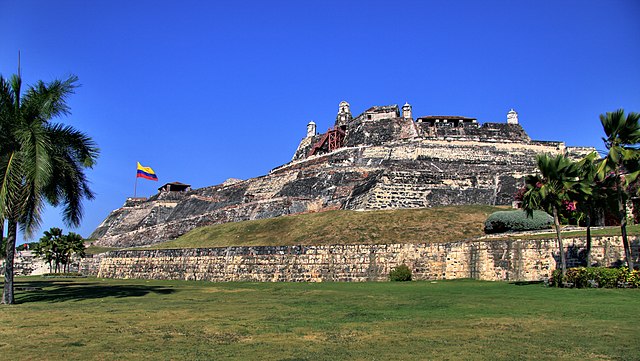
The impressive Cartagena Fortress, created to defend the new strongpoint of the Armada in the new world, in Colombia. The Castillo San Felipe de Barajas is a fortress protecting Cartagena, Colombia, built in 1536 on the Hill of San Lázaro, a strategic location dominating all approaches to the city, by land or sea. The fortress took part in many battles in late 17th to early 19th centuries. The fortification comprised several walls, wider at the base, narrow toward the parapet which protected one another. It had a spectacular grand entrance and complex maze of tunnels. In fact, it was the most formidable defensive complex of Spanish military architecture, towing 41 meters (135 ft.) above sea level. There were more than a hundred heavy bronze guns served by a permanent garrison of circa 4000 men. Even if besieged, rainwater was collected and there was a secret passage for supplies.
To the triangular Castillo de San Felipe, were added batteries Santa Barbara, San Carlos y Los Apostles, Hornabeque, Cruz, Redencion, and San Lazaro which combined 68 additional guns.
San Luis de Bocachica Castillo

Castle of San Luis de Bocachica, definding the approaches of Cartagena, Colombia, built in the 17th century as a star fort. Also known as the Fort of San Luis de Bocachica, is another colonial fortification, located on the island of Tierrabomba, and defending the approaches of Cartagena de Indias in Colombia.
Built between 1753 and 1770 to protect the entrance to the Bay of Cartagena from British and French pirates and privateers it was named after King Louis IX of France (San Luis) and had thick walls, a drawbridge, a moat, and a series of ramparts and towers. It was armed with a battery of cannons and mortars, and was designed to withstand prolonged sieges.
The castle played an important role in the defense of Cartagena during the various wars of independence in the early 19th century. In 1815, it was captured by the forces of Simon Bolivar, who used it as a base to launch his final assault on the city.
Fortín San Juan de la Cruz
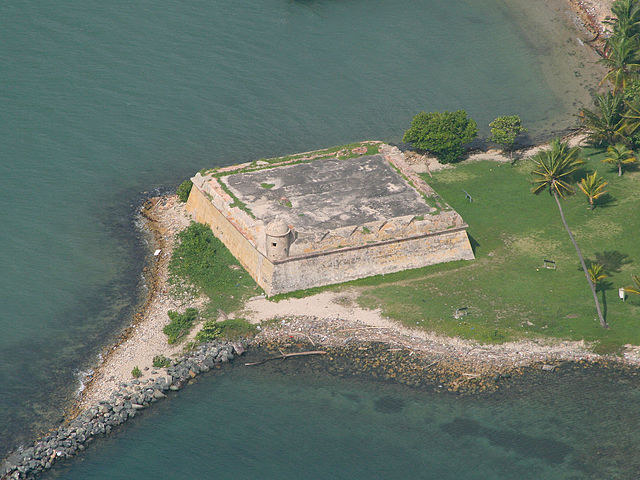
Fortín San Juan de la Cruz, also known as El Cañuelo, is a historic fort located on the eastern tip of the island of Vieques, Puerto Rico. It was built in the 19th century by the Spanish government to protect the island from invasions. The fort is named after Saint John of the Cross, a Spanish mystic and Carmelite friar who lived in the 16th century. It was constructed using local materials, including coral blocks, and its design includes a central courtyard and several defensive structures, including a watchtower and a gunpowder magazine.
During the Spanish-American War in 1898, the fort was briefly occupied by American forces, and it remained under their control until the end of World War II. Today, the fort is part of the Vieques National Wildlife Refuge and is open to the public as a tourist attraction.
Peñón de Vélez de la Gomera

Peñón de Vélez de la Gomera is a small rocky islet located off the northern coast of Morocco, but it is a Spanish territory. It is known for its historical significance as a military fortress and strategic point for control of the western Mediterranean Sea. The rock, which rises to a height of 27 meters above sea level, is located about 120 km east of the Spanish city of Melilla and about 95 km west of the Moroccan city of Al Hoceima. It is uninhabited except for a small garrison of Spanish military personnel.
The Spanish first established a fort on the rock in the 16th century to protect their commercial interests in the region. The fort was later rebuilt and expanded in the 18th century and again in the 20th century, and it has been maintained as a Spanish military outpost ever since.
In recent years, the rock has been the subject of territorial disputes between Spain and Morocco. Despite the challenges, the Spanish have maintained their presence on the rock, and it remains an important symbol of Spain’s historical and strategic ties to the region.
Peñón de Alhucemas
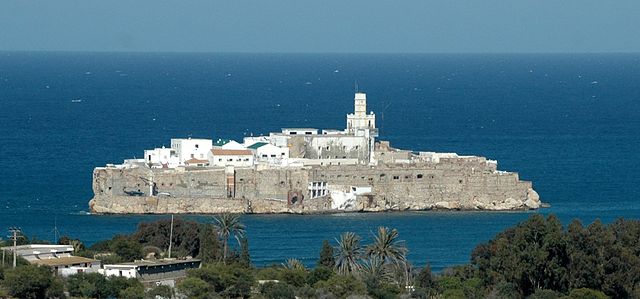
Peñón de Alhucemas is a small rocky island located off the northern coast of Morocco, but it is a Spanish territory. It is part of a group of islands known as the Alhucemas Islands, which also includes the larger islands of Isla de Alhucemas and Isla de Tierra.
The rock is located about 300 meters off the coast of Morocco and is about 220 meters long and 84 meters wide. It is uninhabited except for a small garrison of Spanish military personnel.
The Spanish first established a presence on the island in the 16th century to protect their commercial interests in the region. The current fort was built in the 18th century and has been maintained as a Spanish military outpost ever since. Like Peñón de Vélez de la Gomera, Peñón de Alhucemas has been the subject of territorial disputes between Spain and Morocco. However, the two countries eventually reached an agreement in 2002 that recognized Spain’s sovereignty over the island while granting Morocco fishing rights in the surrounding waters.
Today, Peñón de Alhucemas remains an important symbol of Spain’s historical and strategic ties to the region, and it is still used as a military outpost by the Spanish armed forces.
Chilean Fortifications
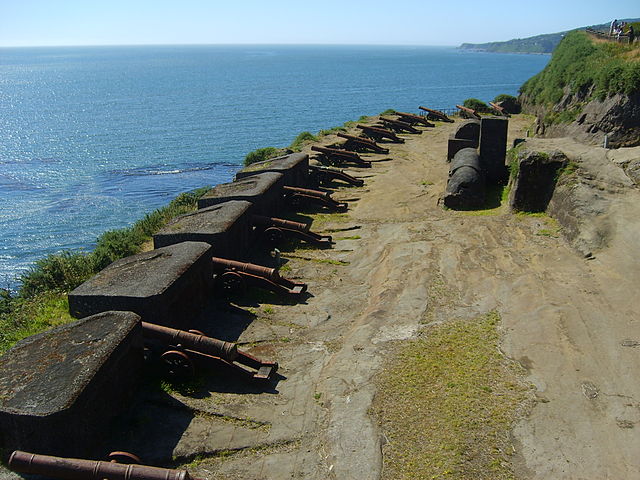
In Colonial times the Spanish Empire diverted significant resources to fortify the Chilean coast, after being rampaged by Dutch and English privateers. The alarm was sounded after the Dutch occupation of Valdivia in 1643. Spanish authorities ordered the construction of the Valdivian Fort System from 1645. During and after the Seven Years’ War, the Valdivian Fort System was updated and from 1764 considerably reinforced, including Chiloé Archipelago, Concepción, Juan Fernández Islands and Valparaíso, this time to face English raids. The former governor Santa María drawn and advises to built a standardized “city-fort” based on Ancud in 1768 placed later under the Viceroyalty of Peru.
Russian/Soviet Fortifications
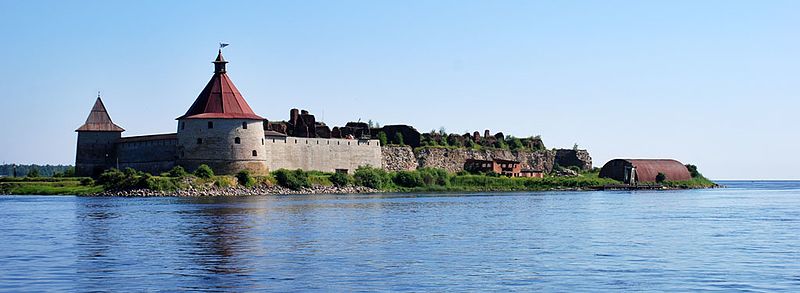
Shlisselburg Fortress, one of a series of fortifications built on Orekhovy Island, Lake Ladoga, well before St. Petersburg was founded by Peter the Great. The first fortress was built in 1323, the scene of many conflicts between Russia and Sweden, changing hands many times.
The history of Russian naval forts and fortresses is linked to the development of the Russian Navy under the impulsion of Peter the Great in the XVIIth Century for the Baltic, an initiative pushed forward in the black sea by Queen Catherine the Great in the next century and compounded all along the XIX century. They played a great role in the Crimean war, but also the Russo-Turkish wars, the Russo-Japanese war, making Port Arthur seemingly impregnable, or also the civil war between the red army and the Russian “whites” supported by Western powers. They even played a role in WW2, notably with the long attrition war at Sevastopol, fixing substantial axis forces for more than a year.
Although the story of medieval and renaissance Russia, wether concerning the principate of Kiev and Moskow, great rivers were also part of the way the country was shaped. The “Rus” Vikings which came from the sea settled there. Their later successors also travelled by rivers down south, and reach Byzantium, becoming the famed Varangian Guard and the trade between the Mediterranean and Baltic spawned dozens of cities along the Dniepr and further Est, the Don, country of the Cossaks. Many large fortresses were built there, including main Cossaks strongholds called “Siech”. They played their part in the XVI-XVIIIth Century. Moskow itself was smack-bang between the Volga and the Oka, used also as mean of fast transportation and trade lanes and controlled by many forts.

Sviyazhsk, built in 1525 to control the Tatarstan
Boyars built small fortresses on some topographical features giving them some advantages. In particular, Sviyazhsk, located in the confluence of three rivers, the Volga, the Sviyaga and the Schuka. In 1586 for example, was constructed the “Samara township” fortress on the Volga. Large Cities like Kazan and Nizhni Novgorod were themslves originally strong fortresses along the Volga, but Saratov (1590) was specifically designed to control trade; the large and fearsome Porkhov Fortress had a whole trading city developing around. As for the middle Volga, a whole serie of Cossack fortresses were erected in the 18th century, armed with cannons to control the river, something older forts can’t do. The famed Ivan the Terrible Sviyazhsk castle proved instrumental in securing Moscow’s victory over the Golden Horde, but so was Wozdwizhenskaya Fortress.
Peter the Great’s Naval Fortress
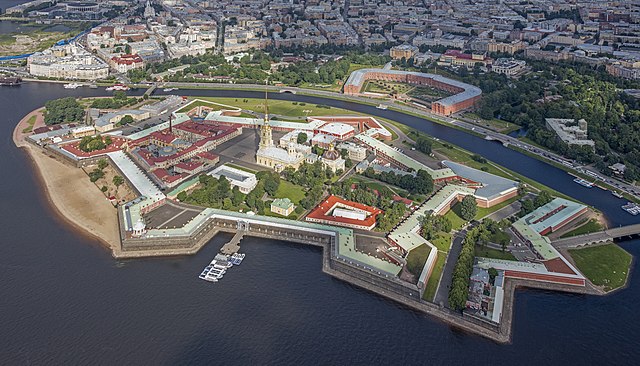
Fast forward and the founder of the Russian Navy, Peter the Great, started with a fortress, but not a Russian one. Instead, Swedish colonists built Nyenskans at the mouth of the Neva River in 1611. Later called Ingermanland it was also inhabited by Finnic tribe of Ingrians and the town of Nyen grew up around it. On 12 May 1703 (Great Northern War), Peter the Great captured Nyenskans and considerably improved and enlarged the fortress.
 On 27 May 1703, closer to the estuary on Zayachy (Hare) Island, he create the massive Peter and Paul Fortress, the first brick and stone building of the new city, which was drawn using a rectangular grid of canals, based on later renaissance plans. In fact the whole city developed around Trinity Square on the right bank of the Neva, near the Peter and Paul Fortress. Later a military port and yards were added, and so new forts were installed to protect the approaches of the new city.
On 27 May 1703, closer to the estuary on Zayachy (Hare) Island, he create the massive Peter and Paul Fortress, the first brick and stone building of the new city, which was drawn using a rectangular grid of canals, based on later renaissance plans. In fact the whole city developed around Trinity Square on the right bank of the Neva, near the Peter and Paul Fortress. Later a military port and yards were added, and so new forts were installed to protect the approaches of the new city.
Peter and Paul was obsolete and in XIXth cent. used as prison and attacked during the Revolution of 1917. Taken by the Bolsheviks and after the signal blank salvo of Aurora at 21.00, her guns fired 30 shells at the Winter Palace and later returned to her role as prison. In 1924 she was mostly converted to a museum.
Kronstadt Fortress
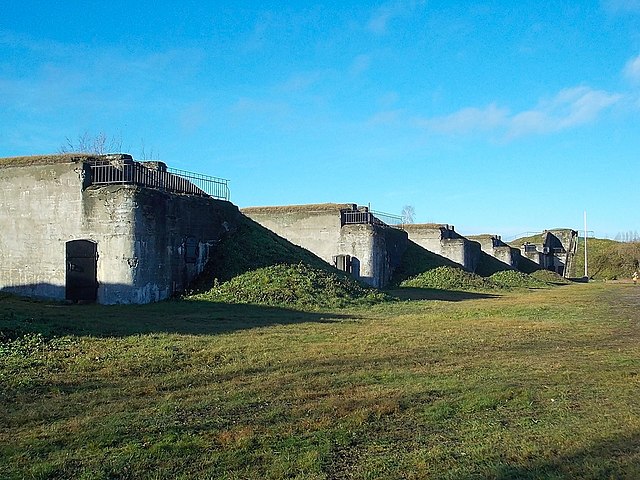
Demidov Battery Today
On 5 April 1784, Admiral Greig signed a plan for the Admiralty in Kronstadt and under Catherine II, transferred it from Saint Petersburg due to the development of the city manwhile. Kronstadt was an island and it was planned, in addition to a fortress, to raise there an office and residential buildings, warehouses and hospitals. The harbor was also dredged. It was catastrophically flooded, fortifications destroyed, cannons washed away in 1824. But she was rebuilt on a new, more modern plan under engineer–lieutenant colonel Lvov.
It took the shape of an irregular quadrangle, protected on the Kotlin Island side by a wall with towers and escarpment. The rest also had an escarpment wall partially replaced by walls of the 1st Western defensive barracks and half–tower rebuilt in 1903–1906, plus the 2nd Western defensive barracks built 1826–1829 also in 1906. The Kronverksky canal was dug and northern city defenses were formed by four Defensive Barracks built from 1831 to 1871, some with semi–towers. There was also the east fifth Eastern Defense Barracks. Breakwaters with platforms for cannons on the sea side were completed by the Knyaz Menshikov battery, protecting the entrance to Srednaya and Kupecheskaya harbors. In 1856, a largely Britsh fleet shelled Kronstadt but was forced to retire, as part of the Crimean war.
In 1904-1905, Kronstadt joined the general uprising after the Russo-Japanese war. The fortress was still troublesome in 1915 but Russians sailors were still patriots and held their position. The fortress was not worried by developing events, the German fleet being busy securing the gulf or Riga; So close to St Persburg, the revolution in Kronstadt in February 1917 was rapid and violent. It was soon claimed by the Bolsheviks and also fought in 1919 against a Royal Navy incursion in support to the white Russians. It was put in the front line of the civil war by Yudenich’s White North-Western Army in May 1919. During the interwar, modernization was limited to the addition of more modern guns, and some AA batteries. But the original fortifications were ill-prepared to sustain modern heavuy artillery or bombs above 500 kgs.
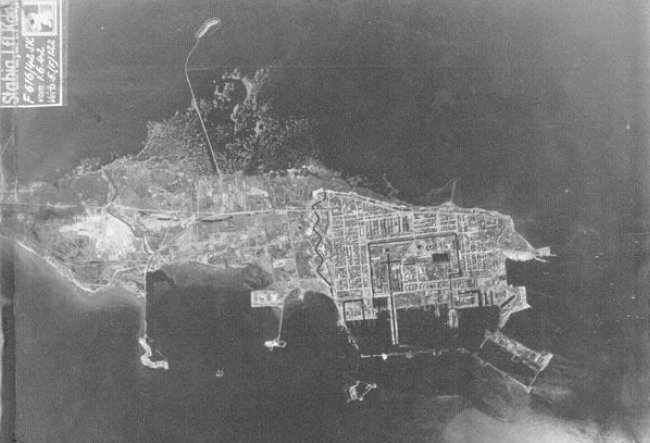
Kronstadt under attack by the Luftwaffe, 1st June 1942
In the late 1930s, the city was the base of the Soviet Baltic Fleet, an important training centre while its dockyard overhauled and repaired surface ships and submarines. Forts and batteries were reconstructed with modern reinforced concrete and the process was still ongoing in 1941. At 23:37 on June 21, 1941, Baltic Fleet Commander Vice Admiral V. Tributs, on order of the People’s Commissar of the Navy Admiral N.G. Kuznetsov mobilized the fortress, hours before the Luftwaffe started to dropp mines into the canal. First lieutenant S. Kushnerev commanded the anti-aircraft batteries and shot down three and damaged several other on 27. The 1st Air regiment of the southern forts would have to repel more raids by the Luftwaffe in August 1941. Stuka ace Hans-Ulrich Rudel took part in it and famously sank the battleship Marat anchored nearby.
To prevent landings, 13 artillery batteries were established and nine more outside the city on Kotlin Island, manned by two infantry regiments. Tallinn was evacuated later and a submarine subdivision organized in Kronstadt, leading 82 naval operations and the Germans tries to block them with anti-submarine nets and mines. by In 1942, the Kronstadt sub fleet sank 29 German vessels and they cooperated with reconnaissance aircraft. Later for the protection of Leningrad, 10 brigades of naval infantry, four regiments, and 40 separate battalions and companies were formed in Kronstadt. The fortress continued to be pounded by field artillery and the Luftwaffe, especially by September 1941 when the dockyard wa ravaged, whereas workers were still on duty 18–20 hours a day. Kronstadt avoided the the destruction of Leningrad, and obtained postwar the title of “City of Military Glory” by Dmitriy Medvedev on April 27, 2009.
Sevastopol Fortress
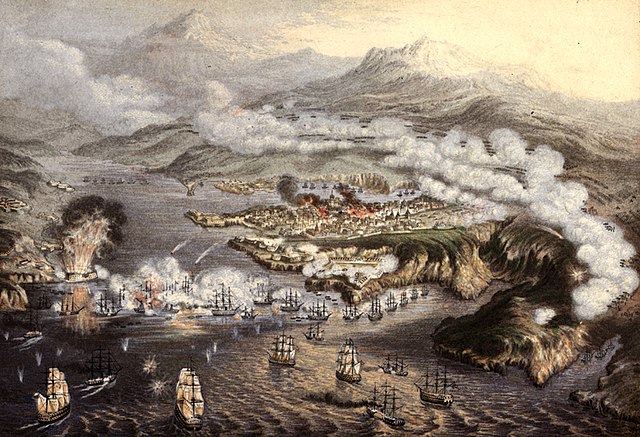
The 1854-55 siege of Sevastopol
Since the humiliation of the Crimean War, Russia had extended the defences of Sevastopol, the main arsenal and base of the Black sea fleet established by Catherine the Great. It was founded already on February 10, 1784. An admiralty and a military settlement were erected first on the deserted shores of the Akhtiarskaya Bay. In 1830, two forts were built, bristling with guns, and completed in 1854. Approaches were defended by two “stone battleships”, the Konstantinovsky and Mikhailovsky forts, erected in 1840 and 1846. Located on both sides of the entrance to the Sevastopol Bay, protecting it from approaching enemy ships.
The Siege of Sevastopol (1854–55) carried out by the British, French, Piedmontese, and Turkish troops during the Crimean War lasted for 11 months and saw pre-ironclad vessels duelling with forts, a distant prologue to the Dardanelles. Decision however was obtained when main forts were taken, and after Malakoff fell, the Russian retired. The following humiliating peace treaty led to severe measures to enhance the defences of the whole area.
In WWI Sevastopol played little role during WWI, apart for the 29 October 1914 back sea raid when the ex-Goeben and Breslau (Yavuz and Midilli) came to bombard the coast. Yavuz shelled the port for 15 minutes, exchanging fire with the pre-dreadnought Georgii Pobedonosets and shore batteries before retiring.
The Black sea in 1905 and Odessa already had been the scene of a famous revolution and the Potemkine mutiny, and naturally was not long to take arms after the 15 March 1917 abdication. It did not fell in the hands of the Bolsheviks however and on contrary, sailors committees were formed on the ships of the Black Sea Fleet commanded by Vice Admiral Alexander Kolchak, later failing to maintan discipline, was recalled by the Kerensky’s provisional government. The city became a “red” stronghold in November-December 1917, the start of the “red terror” with all officers on sight rounded up and shot on 28 December 1917 on Sevastopol’s Malakhov Hill. It was followed by the civil war and fierce fighting with monarchist Whites, lasting until November 1920.
In the interwar, the Soviet naval base was beefed up for more than 15 years and became perhaps the strongest naval fortification in the world. The site presented already a deeply eroded, bare limestone promontory which formed a naturally ideally placed to built fortifications at the southwestern tip of the Crimea. Approach by land forces was very difficult, far more than Port Arthur. High cliffs overlooked Severnaya Bay and protected the anchorage. The Navy modernized the port and placed heavy coastal batteries armed with 12-in and 7-in (180mm) re-purposed battleship and cruiser guns. With their fully revolving turrets they could fire inland as well. Emplacements were protected by a ring of reinforced concrete fortifications for their approaches, plus 9.8-inch thick armored turrets.

A ravaged Sevastopol in 1942
The axis attack started in October 1941 and the battle would rage until 4 July 1942. The fortress was manned by the “Separate Coastal Army” under Ivan Yefimovich Petrov, already reinforced by evacuees from the the siege of Odessa while the The Black Sea Fleet sent 49,372 personnel to fight as infantry. The defence of the city was really a Navy affair through and through, and the blmack sea fleet (One battleship, two heavy cruisers and a Light Cruiser, two Flotilla Leaders and six Destroyers, nine Minesweepers and a Guardship plus 24 Submarines) played little role but AA defense, being sunk with few exceptions by the Luftwaffe. This became one of the largest battle of attrition of WW2, with more than 320,000 losses on the Soviet side, most wounded, and 36,000 on the axis side, including 8,400 Romanians. Even the regia Marine played a role in it, trrying to intercept reinforcements from the Kola Peninsula (which was also attacked).
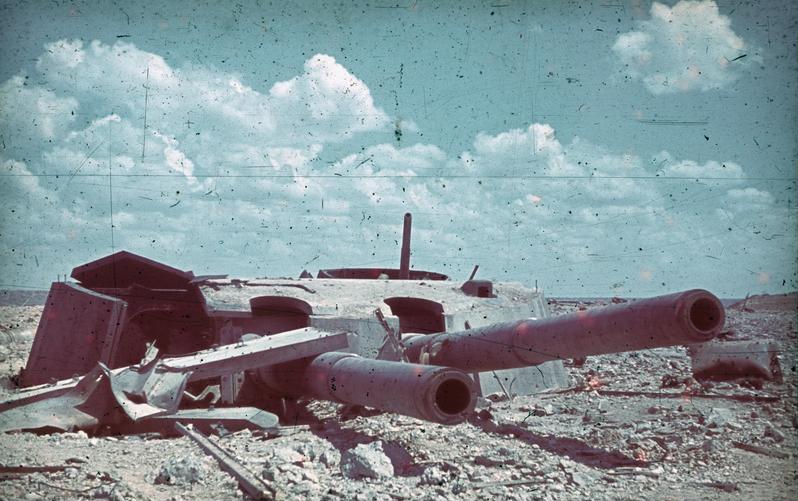
The attack proper on the fortifications was the fiercest from 16 June 1942, the Wehrmacht committed its largest artillery pieces of the war, between giant mortars and the massive 800 mm “Schwerer Gustav” (Dora) special railway gun, concrete-busting special bombs, sappers and special remotelly operated demolition vehicles like the Goliath. In this grinding match, Forts Maxim Gorky, Molotov, Schishkova, Volga and Siberia were eventually overrun. The fall was completed on 30 June-4 July by the Wehrmacht taking forts Oktyabrsky and Petrov. On this last leg, for the June 1942 alone, German field artillery claimed to have spent 67,278 tons of ammunition. The defence os sevastopol gained after WW2 an aura of desperate heroism that still echoes today especially in the Russian-Ukrainian context today.
Vladivostok Fortress
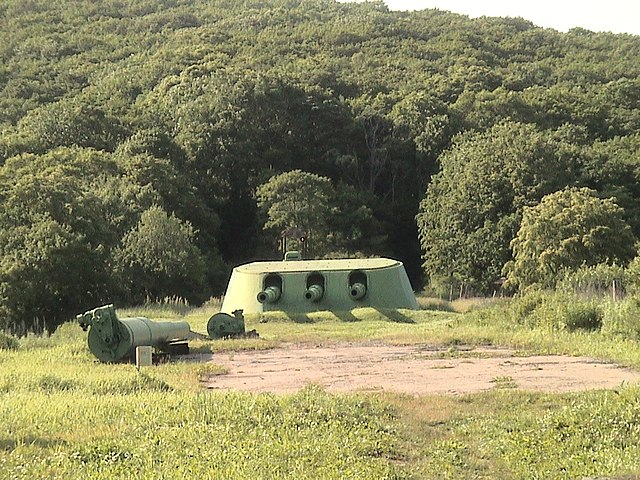
Vladivostock fortress main turret,
Long dubbed the “most powerful sea fortress of all times”, was a the complex of long-term defensive works constructed at the end of XIXth century, expanded and modernized at the the beginning of the XX century. Its construction was 2/3 completed when WWI broke out, and long stopped due to the October revolution. This was indeed a gigantic asset, a complex network over 400 square kilometer territory, with some 130 fortifications, strongholds and shore batteries. In the interwarn, they boasted 1,400 heavy guns alone, absorbing a significant portion of what Obukhoff and other manufacturers was able to produce.
In WWI they never fired a shrt, but for sure deterred any approach from the sea. In 1923, the fortress was sidelined under the terms of the agreement with Japan and permanently abandoned. By the early 1930s however under the impulsion of Stalin the formation of the Marine forces of the Far East had the fortress considered an important linchpin of Soviet defense on the area and the Pacific fleet as a whole. Import efforts were made to rapidly modernize and improve the quarters and installations. Quality and durability of constructions and modernization made it still relevant in WW2.
The Japanese government in fact was deter to not enter war against the Soviet Union outright. In 1934, the Voroshilov battery was built on Russky island after two years of construction. It was largely underground, with state of the art reinforced concrete domes and buried turrets. Two towers were supported by an underground support base under 15 meters. The concrete vault was 3.5 meters thick, bomb proof for almost a ton. The towers were connected also by an underground passage of 200 meters. The massive 12-inches naval guns (305 mm) weighted 51 tons apiece, but traverse was manual; No power generator or steam engine was installed. The battery fired its first shot in 1939. It should be noted that, being over 63 years on action station, the battery fired only practice shots.
In 1941, the fortress boasted on the land front 1290 guns, 268 machine guns, 572 ranged weapons, 64 mortars and 36 rocket launcher, and for the coastal front 316 guns, 56 machine guns and 36 rocket launchers. Until 1997, the Voroshilov battery was still listed as active, now part of a museum, the Voroshilovskaya Batareya Museum which exposes a full triple turret, and the three other salvaged barrels. The other turret was removed and recycled.
Port Arthur
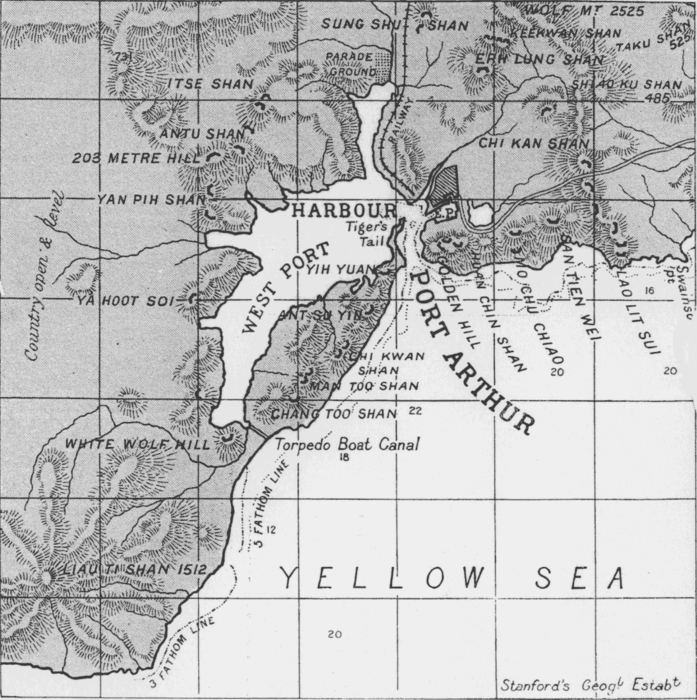
After seeing Kronstadt (Baltic), Sevastopol (Black sea), and Vladivostock (Pacific), the defensive assets of each Russian Imperial Fleet was covered. Or so it was ? Due to the peculiarities of epilogue of the 1st Sino-Japanese war in 1895, Russia seems to reap the fruit of Victory from Japan, obtaining concessions and eventually four years later, signed a 25-year lease on the Liaodong Peninsula. There was a natural anchorage there, on which a new naval base, ideally placed to control Korea and the sea of Japan, was placed. Thus place, with the old fortified city of Lushun, became the naval station named “Port Arthur” (Оборона Порт-Артура, Oborona Port-Artura), turned into the southern dependency of the Pacific Fleet.
Needless to say, it contained, in addition to the 1902 alliance of Japan with Great Britain to counterbalance the growing weight of Russia in the far east, the germs of war. Between 1898 and 1904, so just six years, not a lot in terms opf fortification contruction helped by the first railways lines established to this region, Port Arthur was beeffed up in a matter of a few years with fortifications of a level never seen in Asia, using the latest technologies of reinforced concrete and pillbox, blockhaus bristling with guns of all caliber, 506 in all.
On the other hand, the city was basically a garrison of around 87,000 souls, whereas in 1904, the Russians amassed there 50,000 professional troops, 44,000 volunteers mostly from the nearby city, 12,000 sailors from the Pacific fleet, and 7,000 recruits, mostly Korean and Chinese auxiliaries. The latter made the largest construction effort and to make progresses, troops were commited to the works.
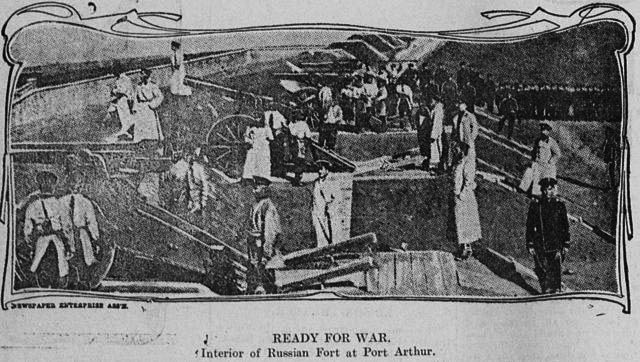
Russian Battery in open air

Ishunkou Fortifications

Tiger’s tail promontory main fort

The main Port arthur Fortress. Most of the gun emplacements are in open air. No turrets were present.
Large batteries turned towards the sea were installed first to protect the approach by sea. However these heavy guns, mostly or 10 inches and 8 inches caliber, were still not covered by casemates. They were in open air at the time of the Japanese attack, unfinished. However the major weakness was access by land behind. Russian improvements therefore included a multi-perimeter layout, with overlapping fields of fire to protect the approaches erected in hill ridges, making the best possible use of the natural terrain.
Many of the redoubts and fortifications were still unfinished in 1904 whereas efforts has been made to improve the fortifications at Dalny further north, for little gain as history shows. Nevertheless some of these hills of the inner perimeter were the best prepared, with a few heavy caliver guns on top, mostly 6 and 4 inches plus mortars, and entire concrete walls along the ridges dotted with embrasures all along bristling with Maxim machine guns. In all perhaps 2,000 of them had been deployed on these approaches.
The main fortress, backing the harbour was buried with a large ditch in front of it, called the “Keekwanshan break”, and the whole facade was dotted with machine gun emplacements. In fact, 1.5 kilometers (0.93 miles) behind this hills defensive lines, the original stone Chinese wall encircling Lushun from the south, to the Lun-ho River (northwest). The Chinese wall was extended to the west and south to completely enclose the approaches to the harbor and New Town of Port Arthur. It was all dotted with with concrete forts with many machine gun emplacements and connecting trenches.
The natural approaches of the hills were barren, featurlesss and devoid of any tree, enhanced by barb wire, for the first time used in a massive way. Mines, whenever possible, were also used. Without any protection, attackers would have to simply charge the Russian defences, which had a perfect arc of fire. For the first time, the Russians turned modified naval mines into land weapons. To avoid surprises by night, electric fences were combined with arc lamp and searchlights. To bolster the land defence at some point, Major-General Baron Anatoly Stoessel decided to strip the damaged Russian vessels in the port of their guns during the siege.
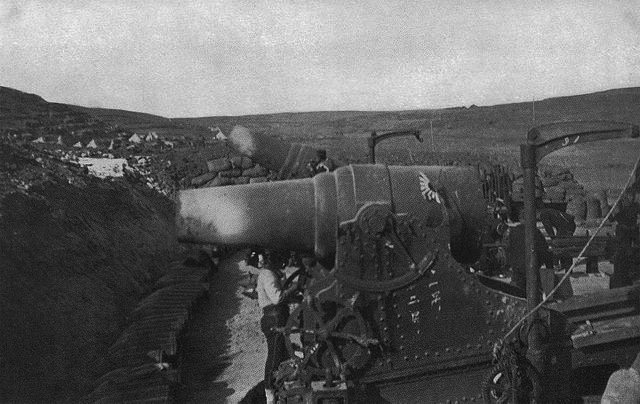
However they underestimated the Japanese response: In addition to Admiral Togo’s night attack of Port Arthur which started the war on 25 July 1894, the Japanese Third Army, about 150,000 strong, backed by 474 artillery guns under the command of General Baron Nogi Maresuke soon landed and started its advance to besiege port arthur by land, on August, 1st. It proceeded first with the Battle of the Orphan Hills from August, 7, to the Battle of 174 Meter Hill on the 13th, and the siege itself, with the Battle of 203 Meter Hill which proved decisive for the Japanese as they could bring on top of the hills their heavy 28 cm mortars, overlooking the port. From there, they destroyed the remnants of the Pacific fleet, which failed to pierce the blocklade and join the rest of the fleet in Vladisvostock. Then, they proceeded to bombard the new city and port installations into submission. Soon after the remainder of Russian forces surrendered. See the Russo-Japanese war in detail and battle of Tsushima for more.
Lessons of the conflict, in many ways determined what a modern fortification could achieve, but also how much modern artillery could be deadly. For the first time also, the conflict saw tactical radio signalling and, in response, radio jamming. Grenades were used very liberally in assaults, and would the siege last a bit longer, the Japanese worked on an early flamethrower and even a portative machine gun. In comparaison the war in the Balkans and the Italo-Turkish only saw more primitive defenses involved, but the concepts elaborated at Port Arthur were well studied by the French Military engineers given reports as per the Franco-Russian alliance, and lessons were passed onto the design of Verdun’s ring of fortifications back in France…
All in all, the assault indeed cost the Japanese far more they had anticipated: They lost 57,780 casualties plus 33,769 sick over a total of 150,000 engaged, thrice the number of Russian defender, according to the old and well-known rule about the prortion of troops needed to overcome a well entrenched enemy. Losses were such that chief commander, Baron Nogi Maresuke wept when explaining his losses at the Emperor, and when the latter passed out, committed seppuku the very day of his funerals, as he was denied to do so as long as the Mikado was alive. Nevertheless it was a painful souvenir for the Chinese too, as the whole population was massacred. A stark anticipation of atrocities to come in the second Sino-Japanese war, 32 years afterwards. The place is now the port and arsenal of Dalian, well known by US analysts. Read more and this.
Naval Forts in the Americas
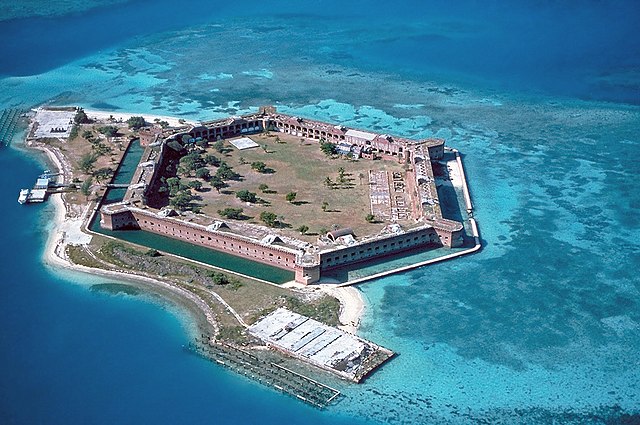
(In writing)
Italian Naval Fortifications
The very nature of the country, an elongated peninsula in the heart of the Mediterranean, not only denied the opportunity to built an aircraft carrer for the Regia Marina’s at least until the battle of Matapan, but also placed an emphasis on naval fortifications since much older times, basically from the Renaissance when artillery, siege warfare and science met together. Since its unifications and independence in 1861, a wide scale survey was done on all the most important ports to turn these into true naval base with coastal defences. With specializes like Ansaldo, Italian artillery was also soon able to ramp up production and the quality and size of tits guns, leading to a gradual increase in naval fortifications and batteries all across Italy, from Genoa to Taranto and Venice.
Renaissance
In Sienna: The Sienese civilian population made a defensible fort with a garrison of 150 men on a key hill-top position which had to he taken before the naval port could be attacked. Further details and dimensions of the so-called Forte Stella are unrecorded, but the ditch and rampart combination was enough to repel the Tercios.
Leros Fortifications (1912)
The Italian Fortifications in Lakki, Leros were erected before WW1. They were the result of Italian occupation of all Dodecanese islands from 1911 to 1912. In 1912, the island was seized by a landing party from the Italian battleship San Giorgio, during the war between Italy and Turkey. Porto Lago was created in the 1930s. Military presence remained for 35 years with fortification build due to the island strategic position and physical form, large natural harbors and to protect the major naval base at Lakki. From there, the Italians could raid the Aegean, Dardanelles, and Near East. The War Museum of Leros, Merikia opened in September 2005 now exhibit many artefacts and plans of the fortifications, comprising batteries, blockhaus and pillboxes mostly around Lekki, with protected observaiton posts on all capes of the Island. The main battery defended Porto Lago.
Venice, Cadorna line and southern fortifications on the Austro-Hungarian border
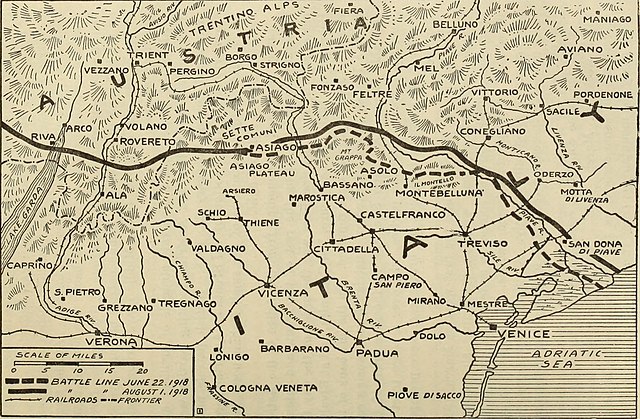
The frontline for Italy went famously through the mountains but also went down to the Adriatic coast, and it started early. In some cases fortifications were not newly built but just developments of earlier structures from the Republic of Venice. Austria-Hungary before loosing the city to Italy in 1866 erected the new forts of the Rivoli and Pastrengo groups to defend Verona. Campolongo and Verena were built in a hurry and had issues, as instead of reinforcing their concrete with steel, stones, wood and waste material went into it. There were fortifications along the Piave, where the land turns flat up to its mouth, with strategic locations at San Dona di Piave, Treviso (as rear base), Motta di Livenza, anf of course Mestre and Venice. The latted already had an old fortfication network going back to the time of the Republic, when trying to defeat the Ottoman threat in the Adriatic and beyond. There’s no wonder why Italy built a substantial number of monitors with a powerful artillery, like Faa di Bruno.
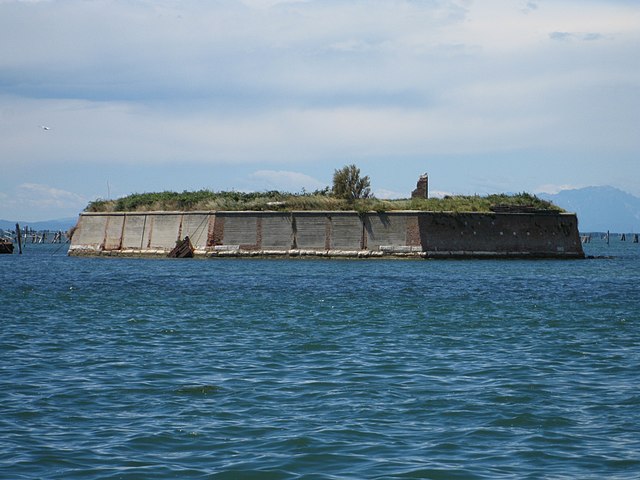
Forte Ottagoni. Several Octagons that had been built on islands at the inlets of the lagoon in 1797.
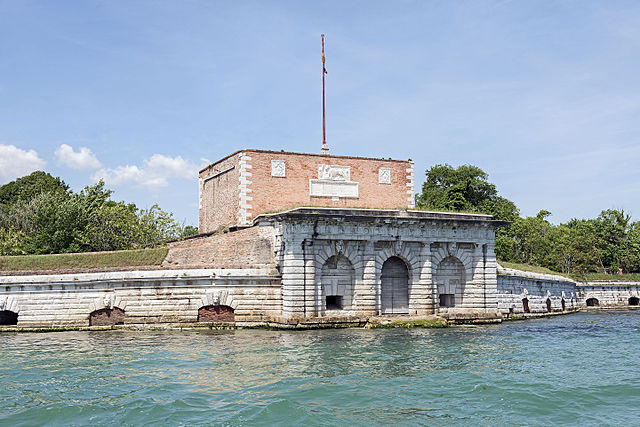
Forte San Andrea.
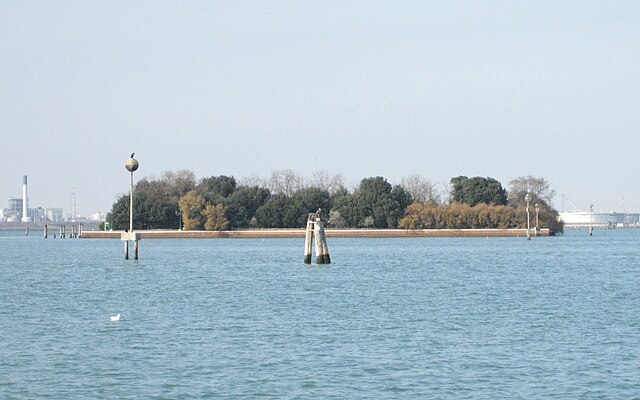
Trezze Island Fort.

Terreperse Battery
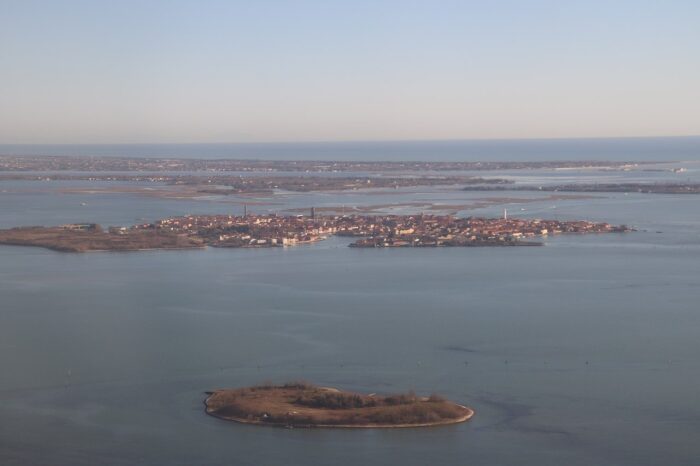
Campalto Island Fort
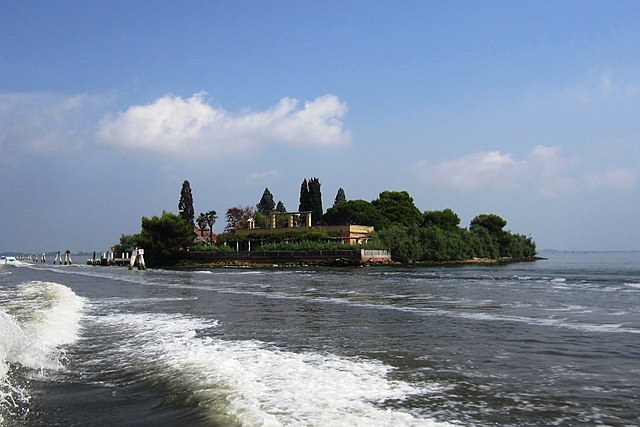
Tessera Island Fort
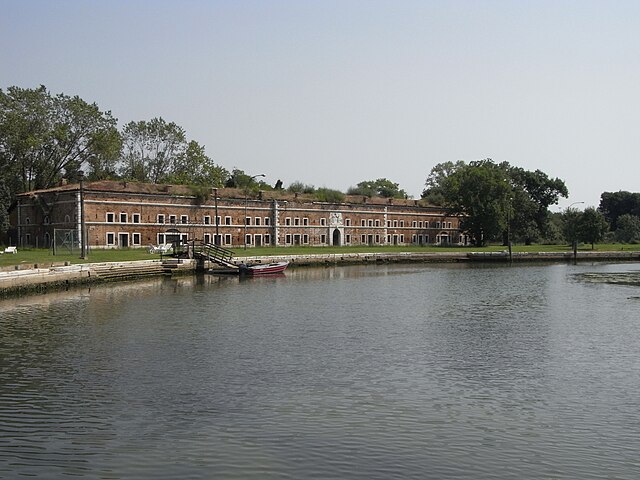
Forte Marghera, 1807-1814: 50 hectares, star-shaped, 60 cannons for over 2000 soldiers, surrounded by moats.
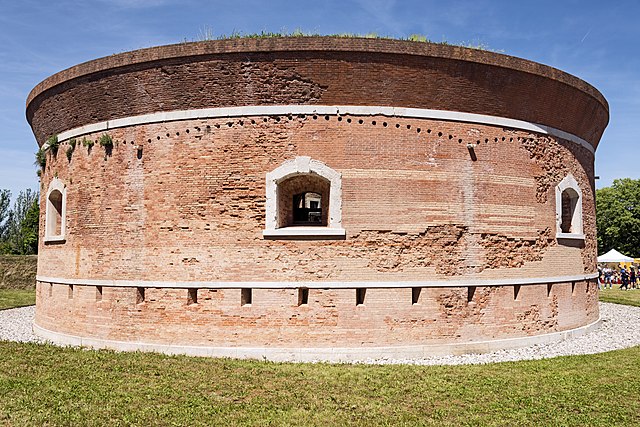
In and around Venice were located a serie of island forts. Let’s cite the Batteria Pisani and Forte Treporti in Cavallino-Treporti, Forte Carpenedo, Forte Gazzera, Forte Mezzacapo, Ottagoni, Forte di Sant’Andrea, Isola di Sant’Erasmo and Torre Massimiliana. Batteries at sea (“unskinkable battleships”) were located at Campalto Island, Tessera Island, Trezze and at the Batteria intermedia Terreperse.
In 1914, many had been long discarded, originally designed for muzzle loading bronze cannons, but more modern artillery was installed in some locations. Venice was indeed Italy’s prime naval base in the upper Adriatic. The second one in the South was Taranto. Given its proximity to the Front, Venice was frequently attacked by the Austro-Hungarians and later German with everything from railway guns to zeppelins.

But the most amazing and modern batteries by far was the Amalfi Battery.
This 381 mm coastal battery was built from 1915 as part of the defences of the Italian city of Venice. The guns were mounted in a twin-turret and were able to hurl the 875 kg weighing projectiles over a distance of almost 20 km. It was installed on a concrete bunker containing the ammunition, sleeping quarters, had electrical generators and hydraulic pumps in separate structures, connected to the main bunker by tunnels. The walls were 9 meters (29 ft 6 in) deep, roof 3 meters (9 ft 10 in) thick. The turret itself’s front was 400 millimeters (15.7 in), sides 300-millimeter (11.8 in), roof 150 millimeters (5.9 in). The cradle mount offered a maximum elevation of +20° for a traverse of 360°.
Trieste: From Roman Fortfications up to WW2
Archaeological evidence on Trieste by airborne sensing and geophysical surveys showed early Roman military fortifications liked to the first year of the second Roman war against the Histri in 178 B.C. as reported by Livy. They were in use until the foundation of Tergeste, ancestor of Trieste. We know about Roman fortifications around many other ancient ports, notably the port of Rome, Civitavecchia. In 1460-1636 the Castle of San Giusto ocverlooking the city was created. Also under Austrian administration the Castalo fi Duino and in 1758-1769 preparation for defense buildings were made, and a new fort was created. Trieste was annexed in 1918. Since the Adriatic quickly became an “Italian lake” no effort was made to modernized the fortifications of Trieste. Only after September 1943 the German recougnised its imporance and started to create defensive line along the coast and hills to protect the territory, port, and shipyards from sea, air, and land attacks. The strong point was on the Opicina hill, with networks of tunnels and bunkers. It was called the “Emil Line” but did not included heavy guns to deal with ships. There was also “Kleine Berlin” (Little Berlin), an underground air raid bunker complex and composed of an Italian side and a German side.
The “guns of Navarone”, true story
The famous novel, leading to the eponym movie in 1961 was oif course fictional, the film showing what could be 24 cm German railway guns installed on fixed positions in a natural cave overlooking a cliff. Useless due to their abense of traverse, this was to make for a great plot anyway. The reality was the real life battle of Leros. The Wehrmacht captured Italian Anlsado 152mm (6 inches) guns but they were the largest artillery present in the island as already decribed above. None were installed in natural cave, and instead, were placed in open positions notably on elevated positions, making them easy prey for artillery and aviation.
During the First World War, Germany used 210mm/90 guns with a 100 km range and a 240 mm gun, originally 380mm/45 recalibrated for long range fire. But the Italians also did work on amazing heavy artillery, usable in coastal defence. In 1917, Ansaldo prposed for defense of the Gulf of Genoa to install long-range, rail mounted guns, but also to shell the Austro-Hungarian port of Pola on the opposite side of the Adriatic coast. Army 380mm/40 and Carracciolo class battleships‘s 381/40 ordnance were used as base, but was not funded, albeit work continued until the 1930s. Mussolini from 1935 wanted one of these “cannonissimo” to placed South of the Sicilian shoreline and shell Malta, known as a British stronghold at the time. This led to a railway mounted 210mm/120 gun on paper, then in 1939, Ansaldo worked on 381 mm, 210mm/120 and 203mm/96.
The Regio Esercito requested for the Regia Marina 381mm railway mounted guns for naval fire in 1929. Ansaldo created in 1930 a 210mm/120 cannon, essentially a rebored 380/40 launching a 115 kg shell a 1500 m/s initially for a range of 95 km at 50° elevation and even 110km at 55° on a modified cradle.
Dispersion was between 6-5 km however at 90 km range. It was tested in August to September 1930, with good results and the railway wagon complex associated rose to 300 tons. This is off-topic there, but there were several Regia Marina’s armoured trains with heavy artillery as well, albeit it was limited to 90 mm dual purpose under shield and 152 mm anti-ship artillery.
381mm Batteries
One 381mm twin-gun turret was built as Batteria Amalfi, Cavallino coast, northeast of Venice, which covered the second battle of the Piave reiver in 1918.
At Brindisi were built the Batteries Benedetto Brin and Fratelli Bandiera from 1916, completed with 381mm Armstrong-Pozzuoli guns in September 1917. The latter wwas to have older 305mm but was modified and delayed for two Armstrong-Pozzuoli guns in 1917 and only completed postwar in 1923. They were roughly identical to the Amalfi battery, except entirely self-contained. Read More (it) and this. They never fired their guns in anger and both were captured by the Allies in good condition during Operation Husky. There were also the Batteria Capo S. Panagia north of Augusta, Sicily, completed in 1934 also with Armstrong-Pozzuoli guns.
Near Genoa after French and later british attacks, two batteries were built, the Batteria Monte Moro in Quinto al Mare-Genoa, and the Batteria Punta S. Martino in Arenzano-Genoa completed in mid-1942, same type as the turret installed in Sicily. These, as Batteria Amalfi were captured by the Germans in September 1943, but used by the RSI, and besieged by partisans in 1945.
In La Spezia were left in reserve a serie of former Schneider-Andaldo Cannone da 381/40 AVS railroad guns as well.
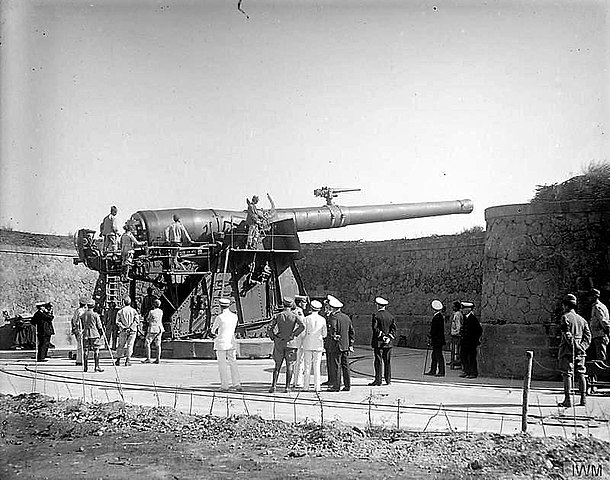
However “classics” were the Cannone navale da 381mm/40 (railroad, 1912) capable of a 30 km range anf the Cannone navale da 381/40 (coastal, fixed also from 1912). The latter was the largest ordnance used in coastal artillery. The others were the 305 mm/46 Model 1909, 305/50 Mod. 1912 and Škoda 30.5 cm/45 K10, a triple-mount Austrian naval gun also used as coastal artillery.
305mm Batteries
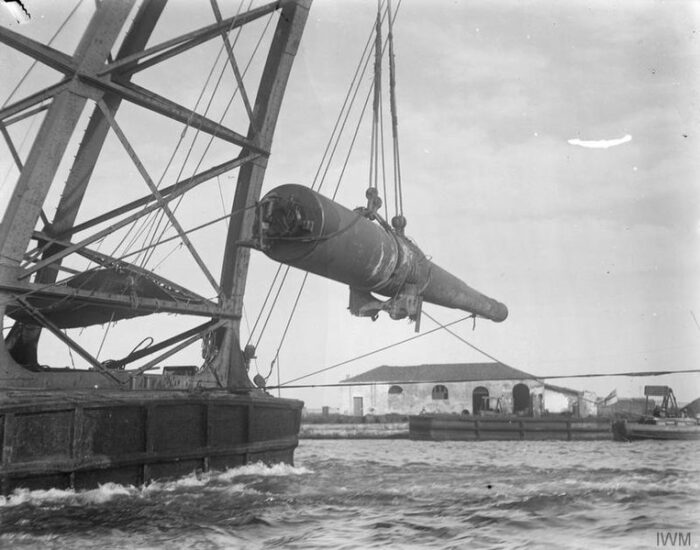
Recovery of Leonardo Da Vinci’s main guns, to be recycled into coastal batteries.
65 Škoda 30.5 cm /45 K10 were buit for the Austro-Hungarian Radetzky-class pre-dreadnoughts and latter Tegetthoff class dreadnoughts. Postwar, SMS Tegetthoff, SMS Erzherzog Franz Ferdinand, SMS Radetzky and SMS Zrinyi were ceded to Italy as war reparations, scrapped between 1920 and 1926 but the guns were salvaged as Cannona da 305/42. They were suggested to be installed at Trapani, Pantelleria, Tobruk, Ischia, Ponza, Leros and Capri. When World War II brok up however only three guns on single mounts were slated for Tobruk but used to at Battery Cattaneo near Taranto. They were still incomplete by September 1943. Another two were to be installed on the monitors GM191 and GM192, never completed. There were also old 305 mm/46 Model 1909 guns from the scrapped Dante Alighieri and salvaged Leonardo da Vinci were also under consideration, as building fortfications were considered to be less costly but limited ammunition supply curtailed such projects.
Naval Base of Navarino (1940)
In October 1940 as the Greek-Italian war flarae up after Albania and the later occupation of Greece by the axis, manu ports and strategic locations received fortifications, and one of the most important, if not the most, was the Italian naval base in the Peloponnese called Navarino (Pylos) called at the time the “first Italian temporary naval base” (prima base passegera) after Taranto. Pylos was one of the most important Italian garrison as well with no less than 15,000 men. There were specific building for many services, the command post, logistics, management of the naval base and port as well as the garrison headquarters alongside its auxiliar services, police, hospital, infirmary, dispensary and an officer’s club.
In Agios Nikolaos were located thee four most powerful coastal artillery batteries providing sea cover and rpelling an Allied invasion. Huge searchlights were placed at the same spot and concrete bases with circularly embedded pins to rivet the guns to the ground with large bolts. Close to pylos this defensive complex Pylos overlooked the town itself, and controlled all of the southern and western passages of the Ionian Sea to mainland Greece. Radio antennas were
placed on Mount Agios Nikolaos in shelters. The port of Pylos and Sfakteria became the “Base of Navarino” under command of Count Ruggerio Ruggeri. The Navarino Base as equipped for the maintenance and repair of auxiliary ships supplying forces in Africa.
At some point in 1941-42, it was the home base for the cruisers Duca D’Aosta, Duca Degli Abbruzzi and Garibaldi as well as six destroyers, ans the repair ship Quariaro, plus Gabbiano class escort ships and a large number of submarines, all permanently stationed in the port. Artillery batteries were initially placed at the centre of Yialova but were moved to a higher ground in Yialova, named “Dapia”. To control road bootlenecks two fortified manned checkpoints were set up backed up with anti-tank obstacles. Inside Niokastro castle were installed a cannon and machine gun on its Acropolis, a second one on the eastern tower of Agios Patrikios, one on the walls of the “Megali Verga” watchtower used as observation post, and two large concrete cannons set at the Hospital and the “spilies” ant the bank courtyard, Roussopoulos Hotel, grove of Pylos while many housed received basements guns coupled with rooftops machine guns, under German advice. The entire defensive cordon comprised 312 guns of all types. Sfakteria island nearby was also fortfied with the largest guns covering passages between there and Leros. After the September 1943 armsitice, the Germans took over and reinforced the defences, including many FLAK posts and pillboxes. In addition, empty barrels and anti-submarine nets were placed at the entrance of the port of Pylos as well as Yialova.
Sources
stefsap.wordpress.com regia marina’s naval coastal guns WW2
fortress-books.com/ amalfi-battery great-war
Italian fortifications on the Austro-Hungarian border
scribd.com/ Batterie-Costiere-in-Italia
https://stefsap.wordpress.com ansaldos-cannonissimo/
The Naval Base of Navarino: Mapping the Fortifications of the Italians in Pylos
Venetian_Works of Defence 16th-17th centuries
seevenice.it/ military fortifications venice and lagoon
Sword and Spade: Military Construction in Renaissance Italy
Modern harbour defence

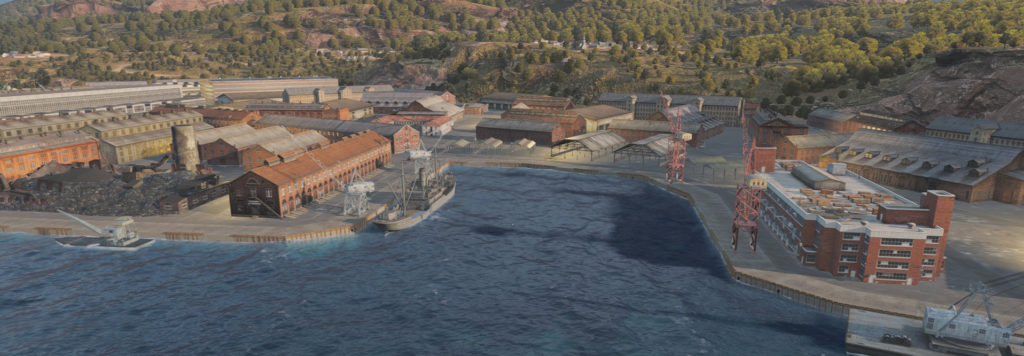
Typical harbour the the early XXth century. Yards, cranes, warfs, rail, were all interconnected, large hangars were used for smaller ships construction, large storehouses for provisional bulk storage, large fuel tanks, oil tanks, captain’s shack and administrative buildings, were all part of the landscape, but no fortifications. Since these vulnerable installations were located inside a cove or bay, the field of fire would have been less than optimal, and if the ship reached that point, that was over already.
But this was only due to the development of long range artillery during the late industrial era. At the start of the XIXth Century, cannonballs and smoothbore muzzle-loaded cannons were the norm and both accuracy and range were limited to 5 kilometres at best. This made harbour fortifications useful, and most of the old coastal cities of Europe were both walls, and fortified on the seaside as well. Ships went into anchorage literally “under the guns” of the harbour in that case. In the Caribbean, at the height of the piracy in the XVIth Century, pirate fleets went duelling with such fortifications, or pound the city itself.
Most of colonial outpost, when grown enough, gained such fortress battery towering over the harbor, this was pretty current in the Carribean, and the Empire-builders of the XVI-XVIIIth Centiry dotted their new possession with these and a good measure of deterrence, even though artillery progress made a 3 battery strong warship plenty of arguments -starting the number of guns- to silence them.
Fortified Lighthouses
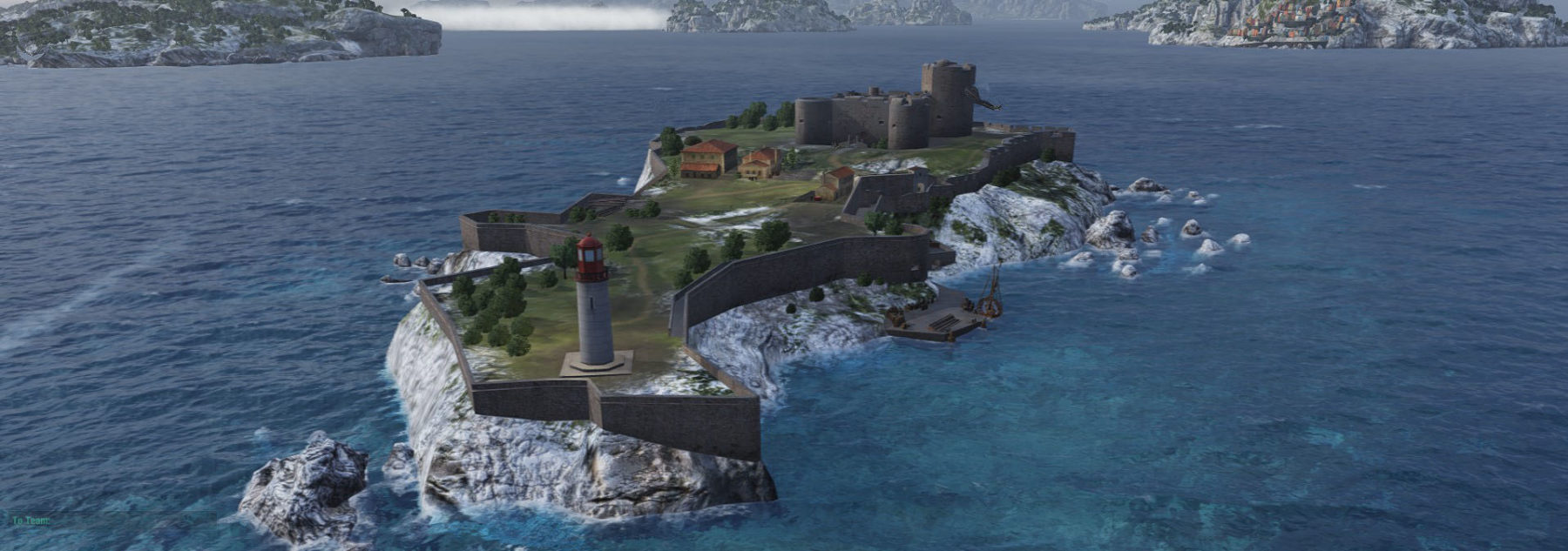
The lighthouse is another specific site narrowly linked, and strategic to coastal operations. We will not go back to the “pharos” of alexandria, perhaps the most illustrious of all, but concentrate here of strategic and tactical considerations about the use of lighthouses. There are currently 21,600 lighthouse today, most still in use, but a large part are being decommissioned and/or converted for touristic purposes. Originally these structures had a specific functions, of marking dangerous coastlines, alerting on nearby hazardous shoals and reefs or rocks, as well as providing a safe entries to harbors in heavy weather and poor visbility. Today they even play a role in modern digital and satellite guided navigation, by ptoviding beacons and assisting in aerial navigation, like auxiliary ACTs.
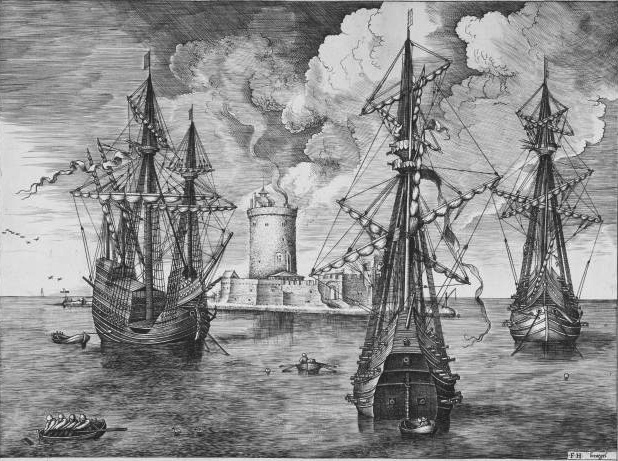
The Punta San Raineri fortified lighthouse, controlling the strait of Messina (Charles Quint)
The idea of blasting out a lighthouse, or just capturing it in wartime was seen as a way to cripple enemy navigation and could enter in the set of blockade strategy in any Navy. There were thousands of “fortfied” lighthouses, but the immense majority were just part of an existing fortification, rather than a self-contained fortfied site. Placed on strategic rocks, often controlling bays or entrances, they were also a tempting site to place artillery. In some cases, they were just the tipping top of an artillery tower, although the blast of artillery could be sufficient to topple over or break the fragile mirror components used.

The Torre del Oro in Seville (painting by David Roberts)

The Torre de Belem, a landmark of Portugal.
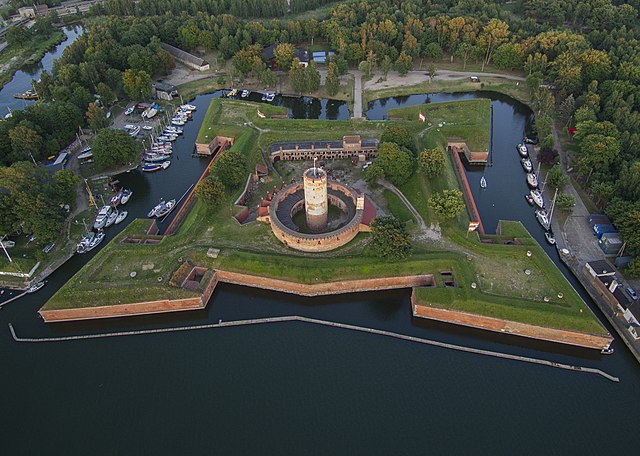
Closer to the XIXth Century, the fortified lighthouse of Wisłoujście Fortress was a regular tower with a permanent fire on top. In Northern France also, Dunkirk, Gravelines and Calais lighthouses were all fortified in the Vauban-style fortess.
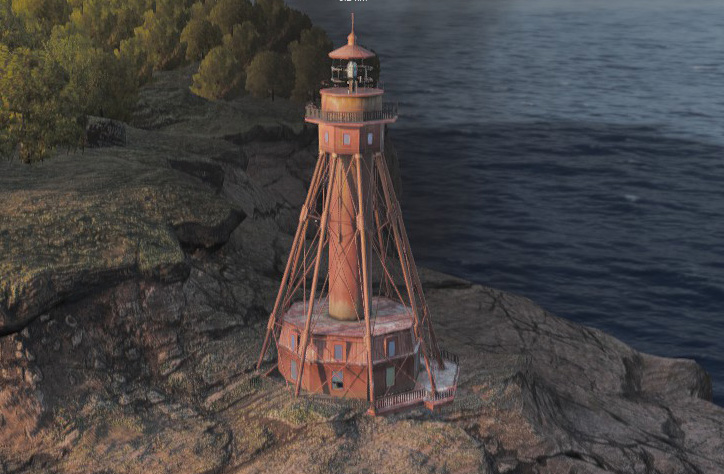
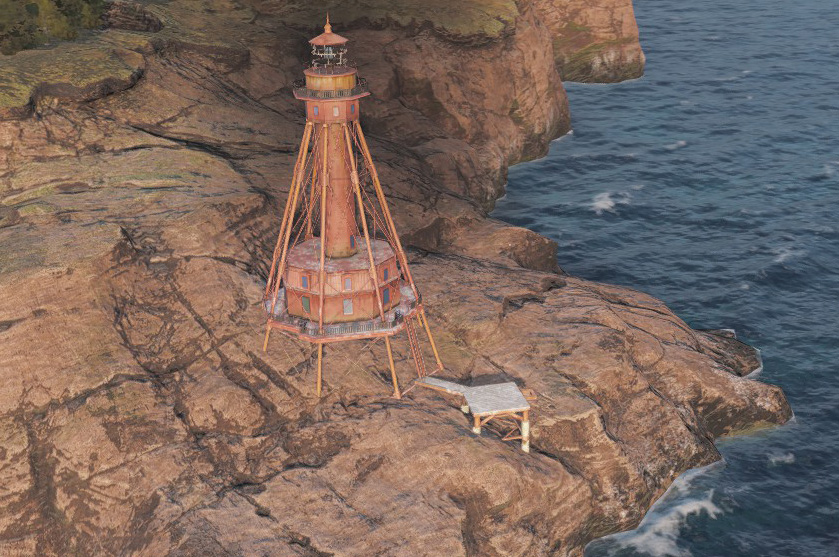
Here a late XXth century Lighthouse
In more modern times, and both world wars, lighthouse were soon found in strategic place surrounded by batteries to prevent their capture. The “fortfication” were merely posterior additions of blockhaus and trenches, with barb wire, light projectors, machine guns nests and artillery batteries. Their only goal was to prevent an enemy landing.
During WW2 the the White Cliffs of Dover covered themselves with naval guns batteries, AA batteries, acoustic detectors, and anti-aicraft projectors. One site in particular, the South Foreland lighthouse complex, was found itself at the forefront of this “Channel war”. It should be nother that the Geneva Convention stopped lighthouses being used for military means. The grounds of South Foreland as a result became an island surrounded by batteries, its light turned off to prevent German shipping direction the tower itself being camouflaged. It was known by the Germans however, well reported in maps, and therefore fired upon at several occasions. Heavy batteries on both sides of the Channel were not only able to criplle any ship passing by, but also to fire almost on the other shore. This particular battery also fired on the escaping German battleships during the ‘The channel dash’ in 1942, with little success due to poor weather. In all the white cliff batteries in the Channel sank or seriously damaged 29 enemy vessels during WW2.

The Hanko Lighthouse, surrounded by fortifications was a focal point in the baltic, between the Finns and Soviets, for the control of the Gulf of Finland during WW2.
Famous Naval Fortifications of WW1
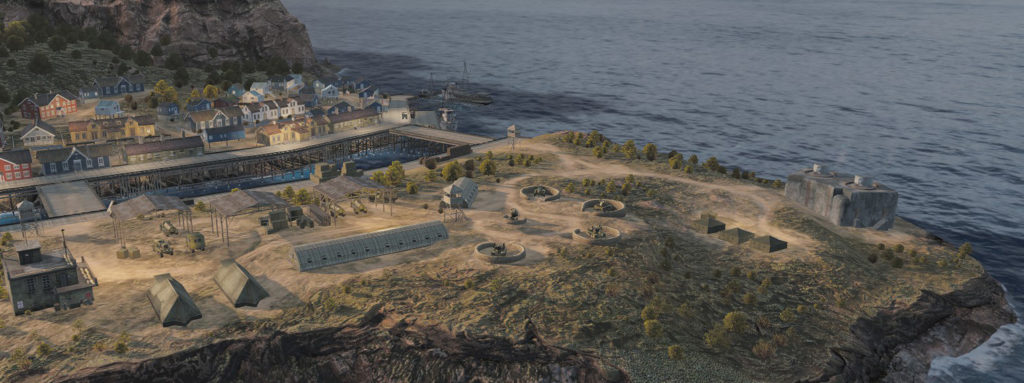
A Typical fortified bunker and associated AA. This was a widespread type or naval fortifications, especially in Scandinavia.
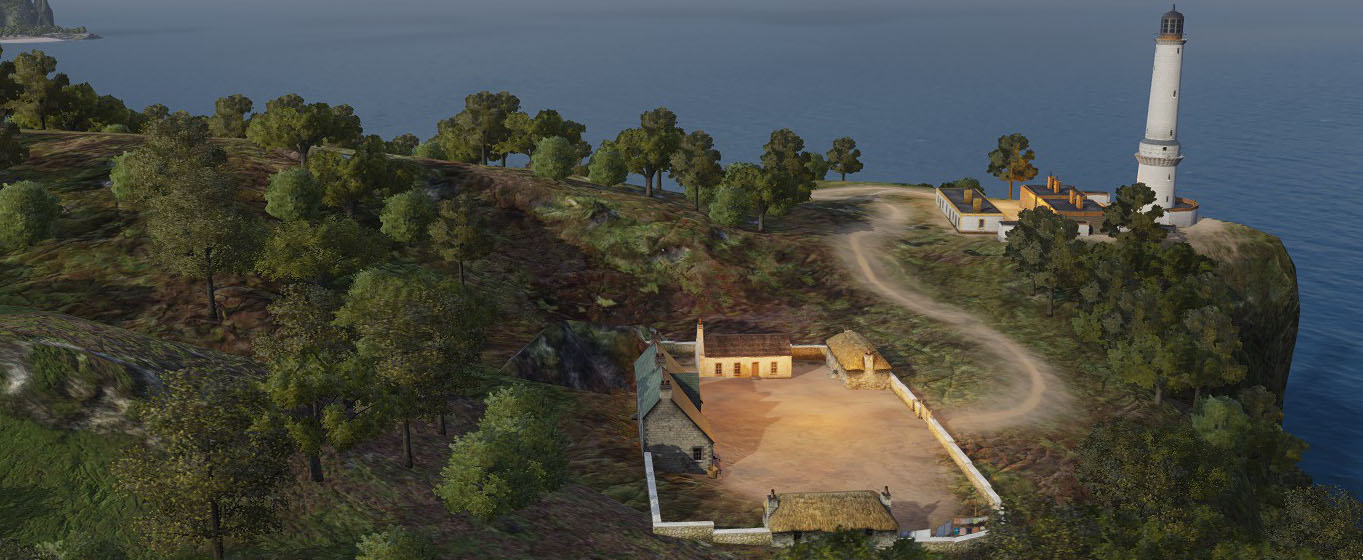
Heligoland
(In writing)
The Dardanelles Forts
(In writing)
Famous Naval Fortifications of WW2
Singapore, the Gibraltar of the Pacific
The Philippine’s “concrete Battleship”
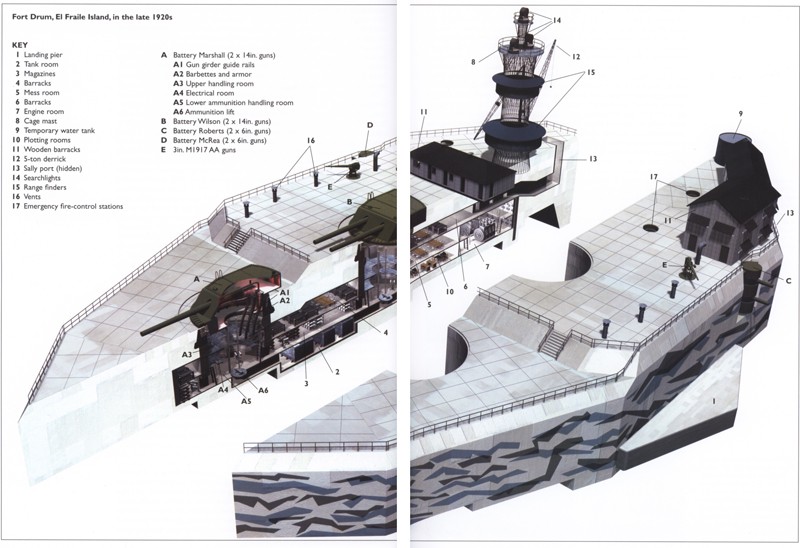
The famous “concrete battleship”, Fort drum (diagram), built on the island of El Fraile, already used as a base of artillery by the Spaniards in 1898.
Located south of Corregidor, between the peninsulae of Cavite (south) and Corregidor (north), which protected the outskirts of Manila Bay, was one of three concrete forts by the Americans in the 1910-1917 years, with Fort Hugues (Caballo) to the north and Fort Frank (Carabao) to the south, equipped with firing positions and firing direction, heavy artillery turrets (Turrets with 356 mm gun pairs).
Fort Drum, begun in 1909, was completed only with the replacement of its old 12-inches (305 mm) cannons by 13 in (356 mm) gun turrets in 1916. The Fort was shaped like a ship and had a “crew” of 320 men with complete living quarters, electric generators, forge, bunkers And stores that allowed him a near-autonomy.

Fort Drum (photo).
Fort Mills and Fort Hughes were built on Caballo just south of Corregidor, a quarter of the island rising to a height of 116 meters on its western side, armed with 17 pieces ranging from 12 to 3in (305 to 76 mm). Four miles south of Fort Hughes was located Fort Drum.
To build Fort Drum, the engineers cut the entire summit of the island of El Fraile to the level of the water; Using rock as a foundation, they built a massive 106.70 m long by 44 meters wide bunker, battled with concrete walls up to 11 meters thick. This giant blockhouse was armed with four 305 mm (from reformed battleships) guns in two double turrets, four 152 mm, and a three-piece anti-aircraft defense of 76 mm.
The southernmost of the fortified islands was Fort Frank on the island of Carabao, just 500 meters from the shore of the province of Cavite. Carabao was 30 meters high, straight out of the sea and was armed with 12 and 3 inches guns, covering the beach of Cavite. And sout of the Bataan peninsula was Corregidor.
On paper, Corregidor looked formidable. Fifty-six coastal guns ranging from 3 to 12 inches (75 to 305 mm), all in fortified bunkers or positions. Two 12-in guns covered 15 miles, twelve 6-in were deadly accurate at 2 miles, and the area was also covered by ten mortars of the same caliber. Nineteen other 5.5 in (155 mm guns) the “long tom”, also had a reach of 17,000 meters. AA artillery consisted of twenty four 3in (76 mm)/48 caliber, many 0.5 in cal. (12.7 mm) heavy machine guns cal, and five 3in night projectors.
Naval Fortifications of the cold war
(In writing)
Read More/Src
en.wikipedia.org/ Gunpowder artillery in the Middle Ages
en.wikipedia.org Coastal defence and fortification
ancient.eu article artillery in medieval europe
en.wikipedia.org Device Forts
worldofbehind.blogspot.com magnificent forts on french coast
en.wikipedia.org Swedish Coastal Artillery
nationaltrust.org.uk south foreland lighthouse
on en.m.wikipedia.org Coastal_artillery
Videos:

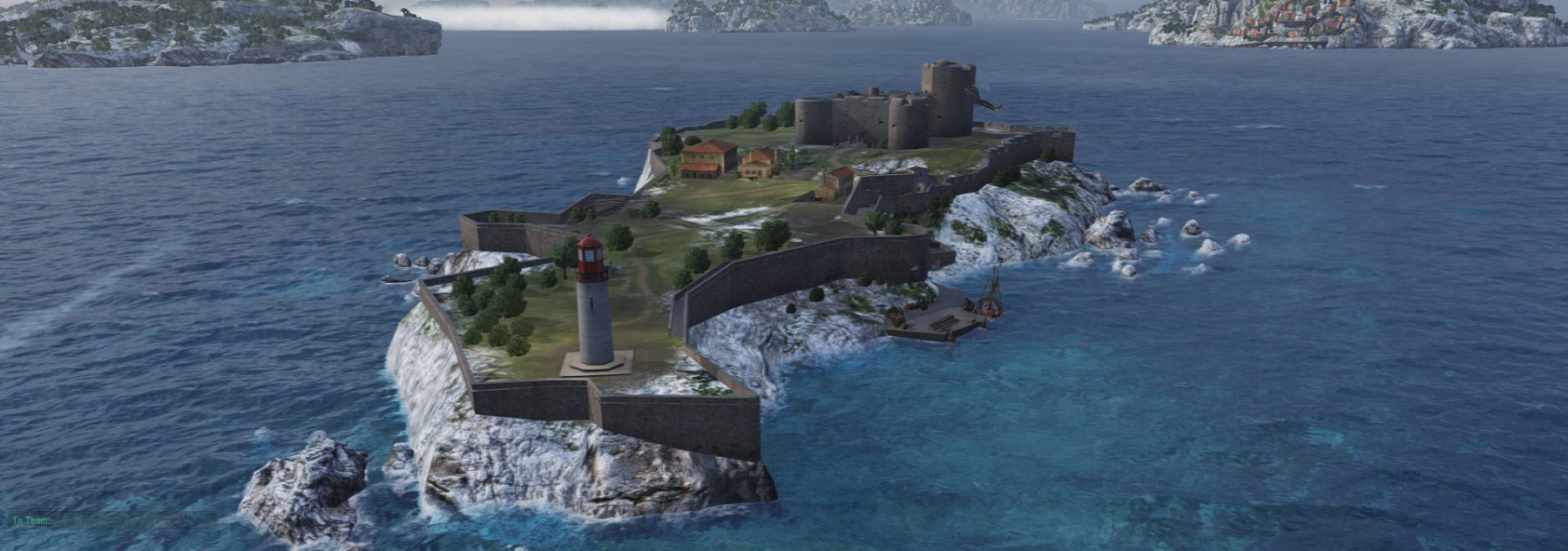

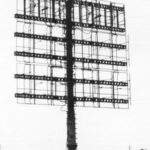
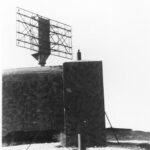
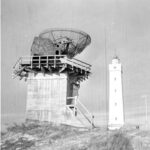
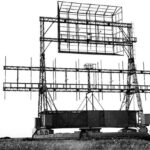
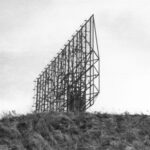
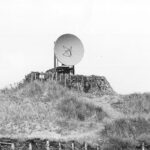
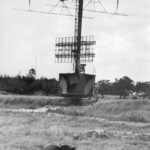
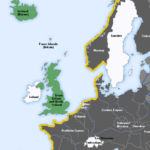

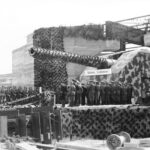

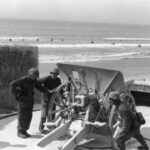
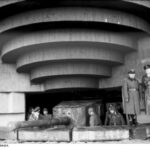
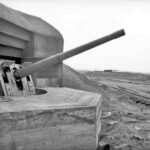
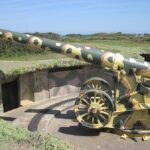
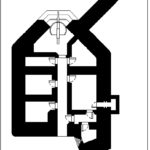
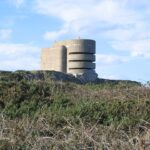
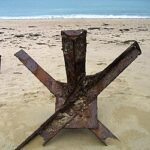
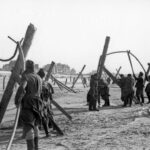
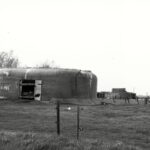

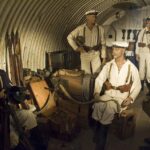

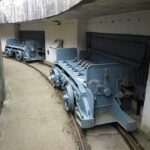
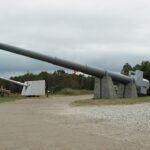
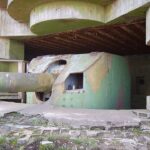
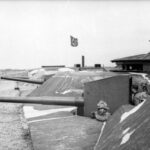



 Latest Facebook Entry -
Latest Facebook Entry -  X(Tweeter) Naval Encyclopedia's deck archive
X(Tweeter) Naval Encyclopedia's deck archive Instagram (@navalencyc)
Instagram (@navalencyc)





 French Navy
French Navy Royal Navy
Royal Navy Russian Navy
Russian Navy Armada Espanola
Armada Espanola Austrian Navy
Austrian Navy K.u.K. Kriegsmarine
K.u.K. Kriegsmarine Dansk Marine
Dansk Marine Nautiko Hellenon
Nautiko Hellenon Koninklije Marine 1870
Koninklije Marine 1870 Marinha do Brasil
Marinha do Brasil Osmanlı Donanması
Osmanlı Donanması Marina Do Peru
Marina Do Peru Marinha do Portugal
Marinha do Portugal Regia Marina 1870
Regia Marina 1870 Nihhon Kaigun 1870
Nihhon Kaigun 1870 Preußische Marine 1870
Preußische Marine 1870 Russkiy Flot 1870
Russkiy Flot 1870 Svenska marinen
Svenska marinen Søværnet
Søværnet Union Navy
Union Navy Confederate Navy
Confederate Navy Armada de Argentina
Armada de Argentina Imperial Chinese Navy
Imperial Chinese Navy Marinha do Portugal
Marinha do Portugal Mexico
Mexico Kaiserliche Marine
Kaiserliche Marine 1898 US Navy
1898 US Navy Sovietskiy Flot
Sovietskiy Flot Royal Canadian Navy
Royal Canadian Navy Royal Australian Navy
Royal Australian Navy RNZN Fleet
RNZN Fleet Chinese Navy 1937
Chinese Navy 1937 Kriegsmarine
Kriegsmarine Chilean Navy
Chilean Navy Danish Navy
Danish Navy Finnish Navy
Finnish Navy Hellenic Navy
Hellenic Navy Polish Navy
Polish Navy Romanian Navy
Romanian Navy Turkish Navy
Turkish Navy Royal Yugoslav Navy
Royal Yugoslav Navy Royal Thai Navy
Royal Thai Navy Minor Navies
Minor Navies Albania
Albania Austria
Austria Belgium
Belgium Columbia
Columbia Costa Rica
Costa Rica Cuba
Cuba Czechoslovakia
Czechoslovakia Dominican Republic
Dominican Republic Haiti
Haiti Hungary
Hungary Honduras
Honduras Estonia
Estonia Iceland
Iceland Eire
Eire Equador
Equador Iran
Iran Iraq
Iraq Latvia
Latvia Liberia
Liberia Lithuania
Lithuania Mandchukuo
Mandchukuo Morocco
Morocco Nicaragua
Nicaragua Persia
Persia San Salvador
San Salvador Sarawak
Sarawak Uruguay
Uruguay Venezuela
Venezuela Zanzibar
Zanzibar Warsaw Pact Navies
Warsaw Pact Navies Bulgaria
Bulgaria Hungary
Hungary

 Bundesmarine
Bundesmarine Dutch Navy
Dutch Navy Hellenic Navy
Hellenic Navy Marina Militare
Marina Militare Yugoslav Navy
Yugoslav Navy Chinese Navy
Chinese Navy Indian Navy
Indian Navy Indonesian Navy
Indonesian Navy JMSDF
JMSDF North Korean Navy
North Korean Navy Pakistani Navy
Pakistani Navy Philippines Navy
Philippines Navy ROKN
ROKN Rep. of Singapore Navy
Rep. of Singapore Navy Taiwanese Navy
Taiwanese Navy IDF Navy
IDF Navy Saudi Navy
Saudi Navy Royal New Zealand Navy
Royal New Zealand Navy Egyptian Navy
Egyptian Navy South African Navy
South African Navy






























 Ukrainian Navy
Ukrainian Navy dbodesign
dbodesign